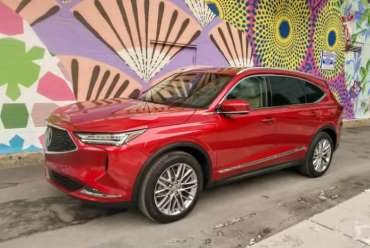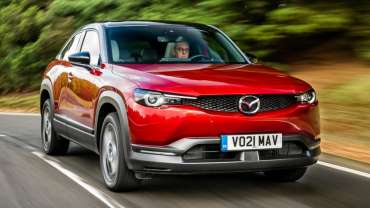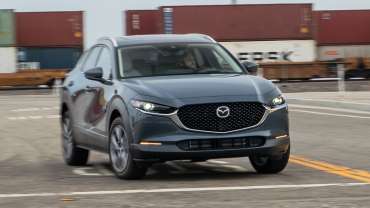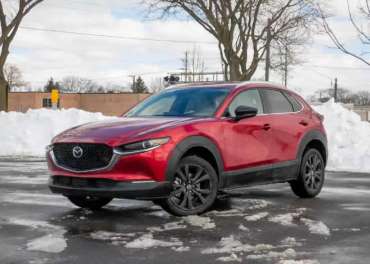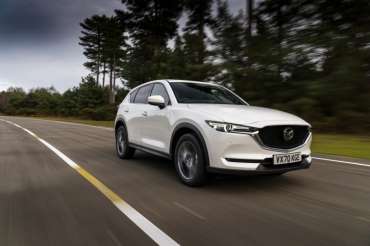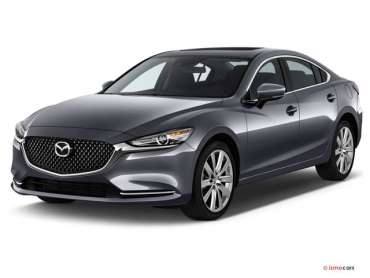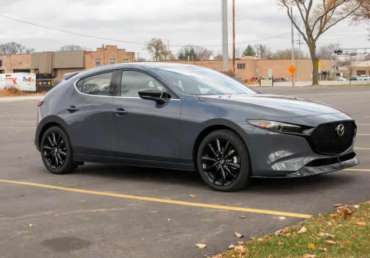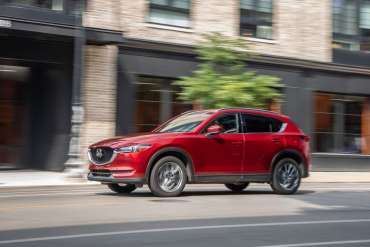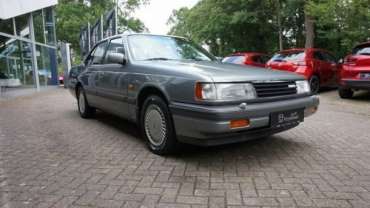Displaying items by tag: Mazda
2022 Acura MDX: 5 Things We Like and 3 Things We Don’t
The 2022 Acura MDX is a fresh take on a luxurious three-row SUV that squares off against strong rivals such as the Lincoln Aviator, Lexus RX, Genesis GV80 and Infiniti QX60. Where the new and improved MDX shines is in value. Even with a starting price of more than $47,000, the 2022 MDX comes standard with loads of safety features and updated tech touches, including wireless Apple CarPlay and Android Auto.
Inside, Acura’s engineering team focused on creating a more functional and flexible place to spend your time. The center seat in the second row can be used either like a bench seat, which accommodates three car seats across, or removed so the outboard seats become captain’s chairs. There has also been a substantial upgrade to the MDX’s infotainment system, though this also proved controversial during our test.
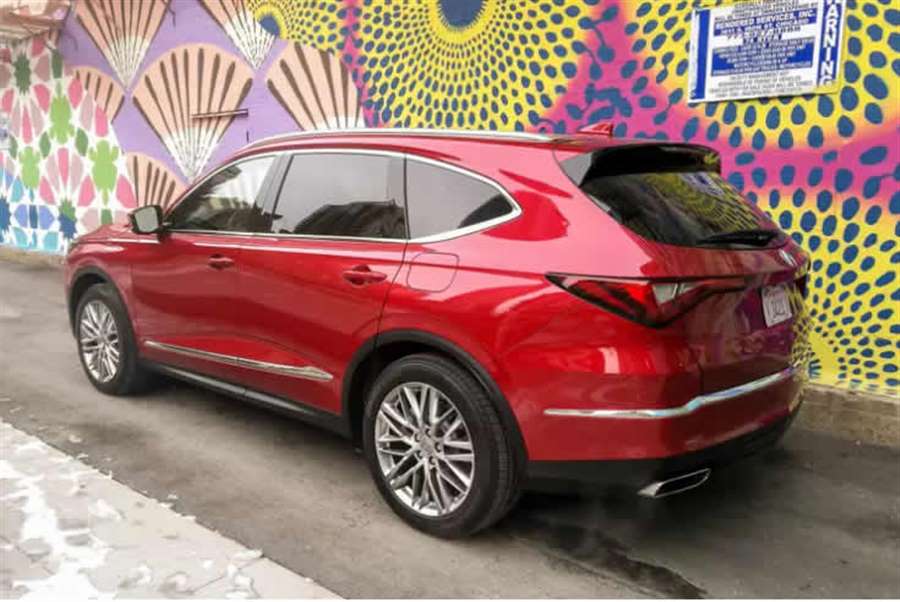
You can click the related link above to read our complete review of the 2022 Acura MDX. Or for a quick recap of this mid-size luxury SUV’s best attributes — plus some items that need a rethink — keep reading below.
Things We Like
1. Smooth V-6, Improved Transmission
Under the hood is a 3.5-liter V-6 that sends 290 horsepower to the front wheels courtesy of a 10-speed automatic transmission; all-wheel drive is optional. This is a smooth and refined powertrain, and the gearbox in particular is a solid step forward from the previous nine-speed automatic. There is no hunting for gears or hesitation in acceleration when powering through city or highway traffic.
2. More Standard and Optional Safety Features
The previous Acura MDX already came standard with an impressive amount of active safety equipment, such as automatic emergency braking, forward collision warning, adaptive cruise control and lane keep assist. Newly standard safety items include a driver attention monitor, pedestrian detection, traffic sign recognition and Acura’s Traffic Jam Assist. This system controls braking and acceleration at slow speed and works to a complete stop, all while maintaining a safe distance behind the vehicle ahead. The aim is to reduce driver fatigue during traffic slowdowns.
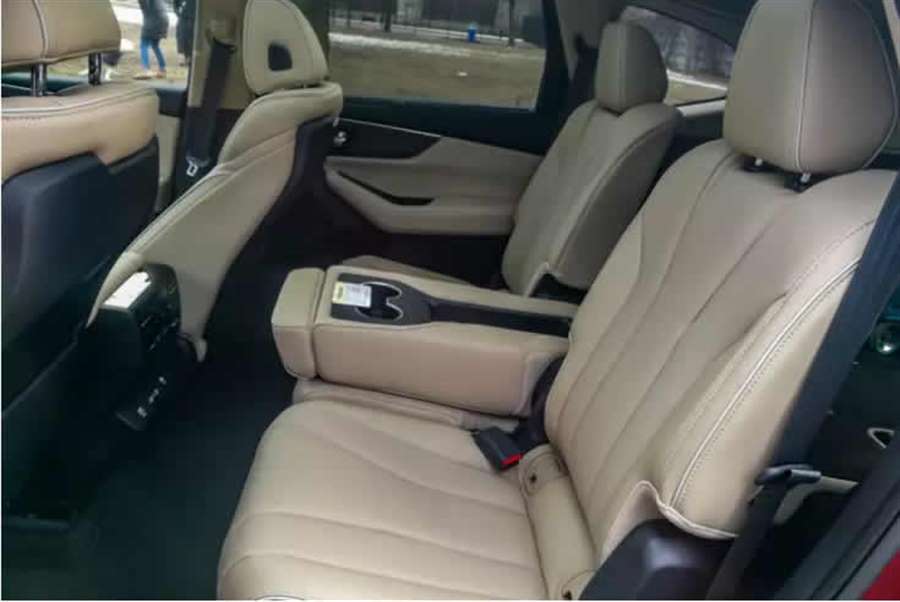
3. Seating Flexibility
The MDX still offers three rows of seating and space for up to seven people onboard. Yet, for the 2022 model year, the second row packs some surprises. The middle seat can be removed to create a nearly 14-inch wide walkway to the third row. This creates more stretch-out space for second-row occupants, and makes it easier to access the third row. Along these same lines, with the push of a button the second-row seats collapse and slide forward to aid anyone climbing into the rear-most seats.
4. Creative Cargo Space
Like the improved seating capabilities, Acura also turned its attention to the MDX’s cargo area. Not only is there more total space behind the third and second row than what rivals offer, the MDX has a few extra cards up its sleeve. There is a roomy underfloor storage compartment as well as a reversible cargo floor with an easy-clean plastic side. Need to haul muddy hiking gear or a particularly dusty antique? Flip the cargo floor and don’t worry about dirtying the trunk’s carpet.
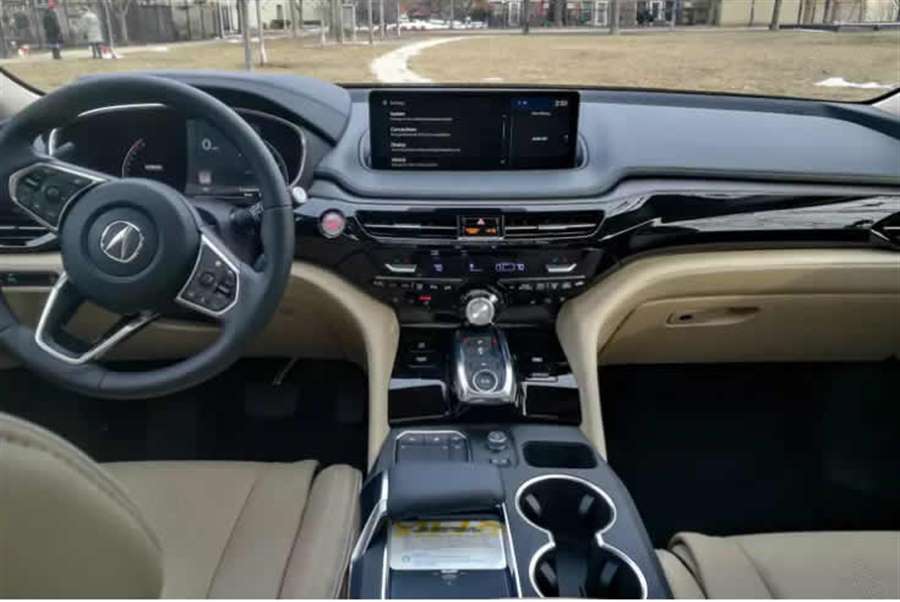
5. Improved Infotainment — to a Point
The good news is that the 2022 Acura MDX has a more intuitive and user-friendly infotainment system than the dual-screen setup used in its predecessor. Wireless Apple CarPlay and Android Auto are now standard, and we found the Amazon Alexa voice controls very handy. The system now comes with a large 12.3-inch screen mounted on the dashboard. While the display is large and clear, things get murky when it’s time to scroll through various menus and controls. More on this in just a moment …
Things We Don’t
1. Fussy Infotainment Controls
While the MDX’s infotainment system is better than before, it still lacks an actual touchscreen. That’s right, the primary means of controlling the system is via a center console touchpad. It takes lots of patience, practice and some luck to get right (especially when you’re driving). The major pieces are all there; Acura is simply short a touchscreen to make everything perform seamlessly.
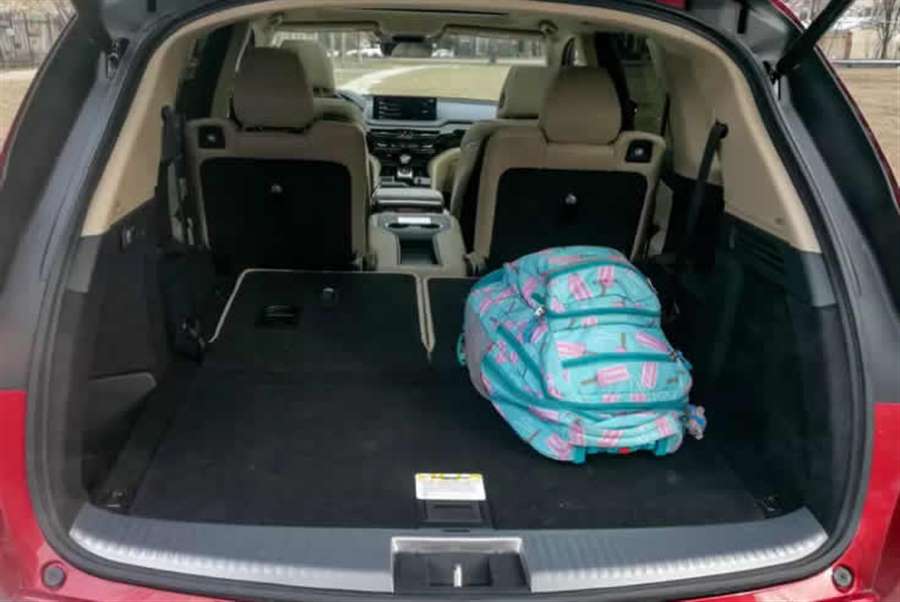
2. Third Row Remains Best Left for Kids
Getting to the third row is easier for 2022, though the space back there is still best left for kids. Anyone feeling greedy about legroom while perched in the second row will be a serious problem if the MDX is at full capacity. With a second-row seat slid all the way back, there’s not much third-row legroom directly behind it.
3. MPG Is Only OK
The Acura MDX isn’t much better or worse than its mid-size luxury SUV rivals when it comes to mpgs. It’s also not any better than the previous version. In fact, the 2022 Acura MDX is slightly less fuel efficient than the model before it. The difference is small, though it would have been nice to see the new MDX’s overall fuel economy needle move upward, not down.
Mazda MX-30 SUV review
"The Mazda MX-30 is a stylish electric SUV that's fun to drive and affordable"
This is the Mazda MX-30, the first all-electric model in the history of the Japanese manufacturer. It looks stylish, and in keeping with the brand's other models, it's also fun to drive.
Mazda isn't afraid to go its own way, and unlike rival car makers who are locking horns over battery capacity and range figures, the MX-30 instead gets a relatively small, lightweight battery pack. This helps it stay nimble, and Mazda reckons its 124-mile range is also enough to satisfy the driving habits of its target audience, most of whom own another car.
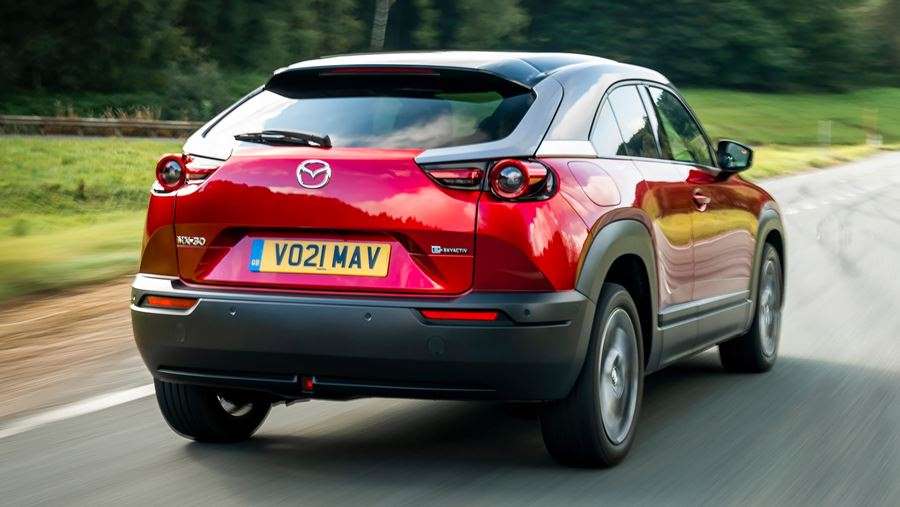
The battery has a 35.5kWh capacity, and Mazda believes using a smaller pack not only boosts handling, but also has less impact on the environment and keeps the MX-30's price down. Speaking of which, the MX-30's list price of around £27,000 (including the government grant and a home charger) is noteworthy, because it means even in the well-equipped First Edition trim it's cheaper than the equivalent higher trim versions of the MG ZS EV and Nissan Leaf.
It can be charged using a home wallbox supply in less than six hours, or topped up from 0-80% in 36 minutes using a 50kW rapid-charger. Handling is certainly a strong point; the MX-30 can flit between corners without fuss and Mazda's well-weighted steering and feelsome brakes have also made the transition from combustion to electric power intact, but with 143bhp, performance is fairly modest for an EV. Acceleration from 0-62mph takes 9.7 seconds, compared with 8.5 seconds for the MG ZS EV, and the MINI Electric feels much quicker off the mark.
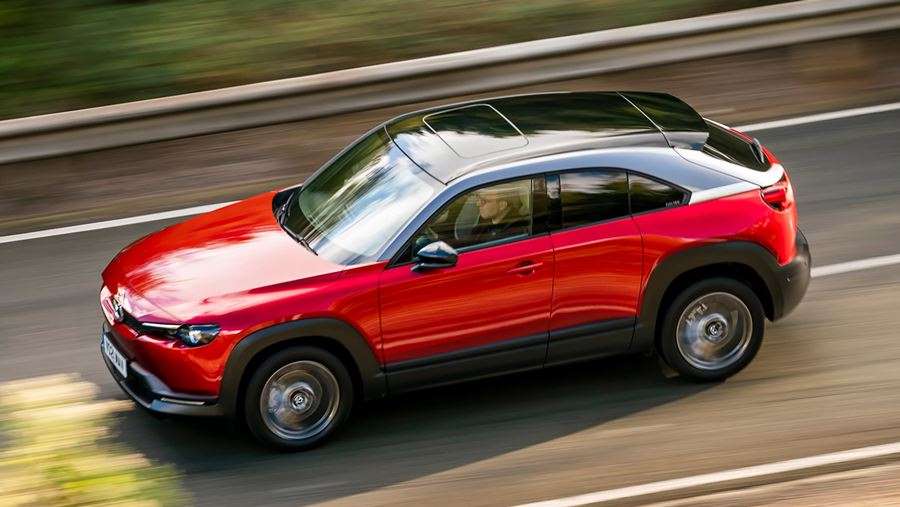
Looking like nothing else with a Mazda badge, the MX-30 features rear-opening back doors, hindering practicality somewhat. There are five sets of seatbelts but getting in and out of the rear is slightly awkward, and the back windows cannot be lowered, making it claustrophobic for rear passengers. Life is far better in the front, thanks to comfortable seats with a vegan-friendly leatherette upholstery, cork trim inserts and door trims using recycled plastic bottles. Mazda has been making some great interiors in recent years, and this is no exception.
The first 500 UK cars were all First Edition models, which came with a strong kit list including a heads-up display, sat nav and digital instruments. The standard model range comprises SE-L Lux, Sport Lux and GT Sport Tech, all of which are well equipped.
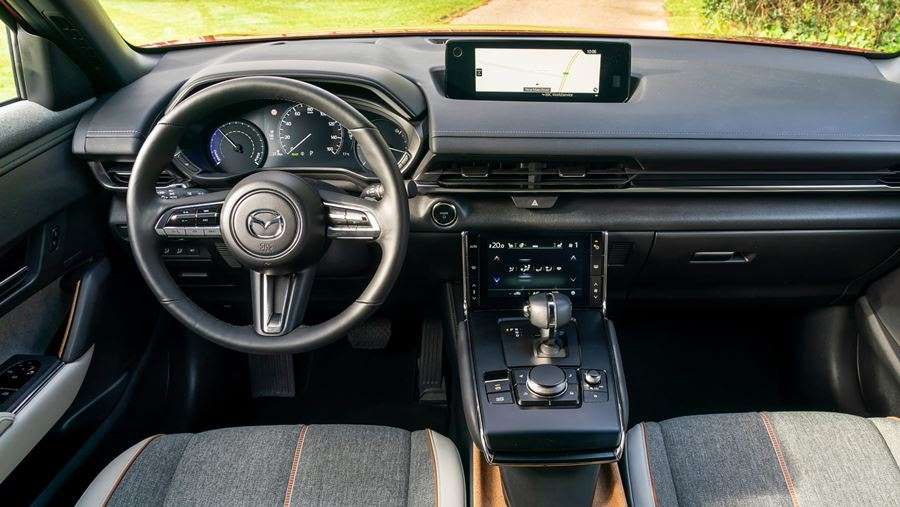
The Mazda MX-30 also bagged a five-star safety rating from Euro NCAP in 2020, with impressive crash-test results across the board. Plenty of smiles from behind the wheel, an attractive interior and low running costs will impress buyers, but they'll need to only carry rear passengers very occasionally and be happy with the car’s limited range.
MPG, running costs & CO2
Forget range anxiety and Mazda's decision to offer a smaller battery pack makes sense
As with its SkyActive petrol and diesel engines, Mazda is looking to buck common trends with its first EV. Instead of engaging in a race to fit the biggest battery pack possible, the MX-30 instead has just a 35.5kWh capacity, giving it up to 124-miles range between charges. While such a short range is easier to forgive for city cars like the MINI Electric and Honda e, it's harder to justify for a bigger one. Most rivals such as the Tesla Model Y and Volkswagen ID.4 will easily double this.
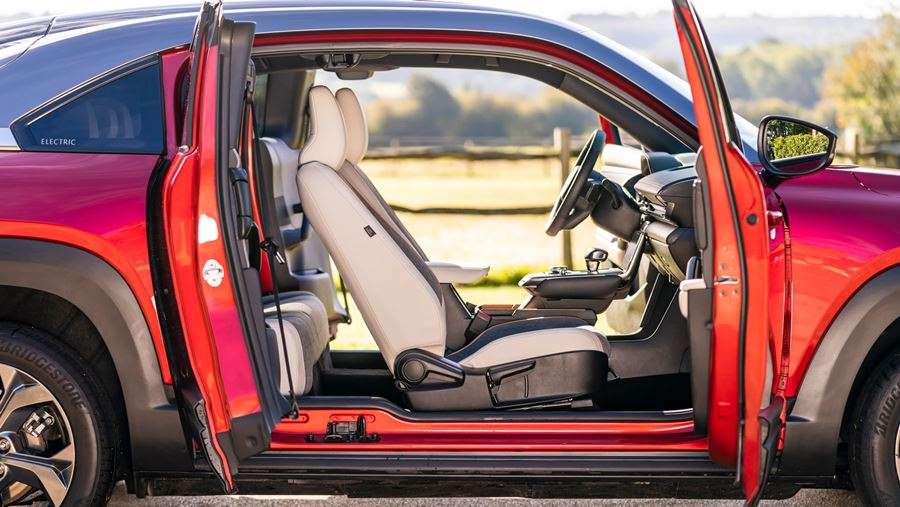
Mazda's thinking is that production of larger battery packs is bad for the environment, and that they're heavy, negatively affecting how the car drives. Mazda also points to research that 95% of the MX-30's target buyers drive less than 60 miles a day. They're the sort of drivers who are likely to tackle the school run, commute to work and drive locally to shop or see friends, rather than regularly travel long distances on the motorway. It's also likely they'll plug the car in overnight at home whenever it's necessary, and a free home charger comes as part of the deal.
A full charge takes less than six hours using a 7.4kWh wallbox, but it's also possible to charge the MX-30 at up to 50kW using a public rapid-charger and its CCS connection. Do so and the battery can be topped up from 0 to 80% in 36 minutes. The range-topping Volkswagen ID.3 offers up to 125kW rapid charging. VED (tax) is currently free for electric cars, which also enjoy the lowest rates for company-car drivers and free entry into low emissions zones like the one covering central London. There's also a major advantage for company-car drivers, thanks to low Benefit-in-Kind (BiK) liability, reducing monthly bills.
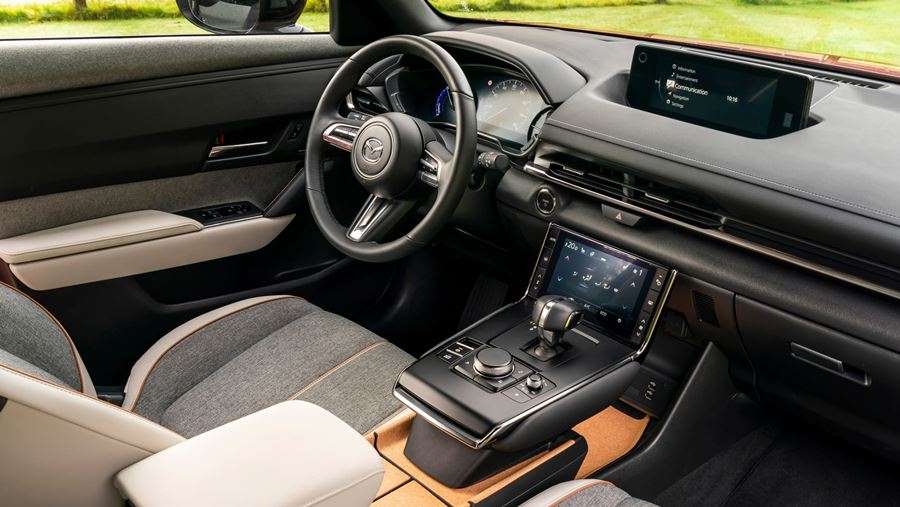
Engines, drive & performance
It doesn't have screaming acceleration, but the Mazda MX-30 is a satisfying steer
The 'MX' badge is usually reserved for Mazda's sporty models, such as the iconic MX-5 roadster, so is it deserved here? Weighing around 1,600kg, the MX-30 is certainly light compared with other electric SUVs, and this pays dividends in almost every driving situation. There's never any feeling of dragging the MX-30 around corners, instead, it's agile and quick to respond, with very little body lean. In fact, we found its handling finesse makes it almost as fun to drive as the smaller MINI Electric, even if it doesn't have as much punch when you hit the throttle. Its steering is precise and requires just the right amount of effort.
Mazda MX-30 SUV front cornering20he brakes feel natural too - not always a given in alternative fuel cars that harvest energy from braking regeneration. The strength of the electric motor's braking effect can be adjusted on the move via the paddles mounted on the steering wheel. Even in its strongest mode it doesn't quite allow for one-pedal driving, but you can learn to use it to slow the car in predictable traffic - only using the brakes for unexpected stops.
Just don't expect acceleration worthy of 'reaction videos' on YouTube as your friends are pinned back in their seats, Tesla-style. With 143bhp, the MX-30's electric motor feels more on a par with diesel rivals for acceleration, taking 9.7 seconds to get from 0-62mph. Top speed is limited to 87mph. Of course, with just one forward gear and no turbo lag, there is the benefit of smooth progress as soon as you press the throttle. You'll also notice a synthetic engine sound to help make the MX-30 feel natural for drivers.
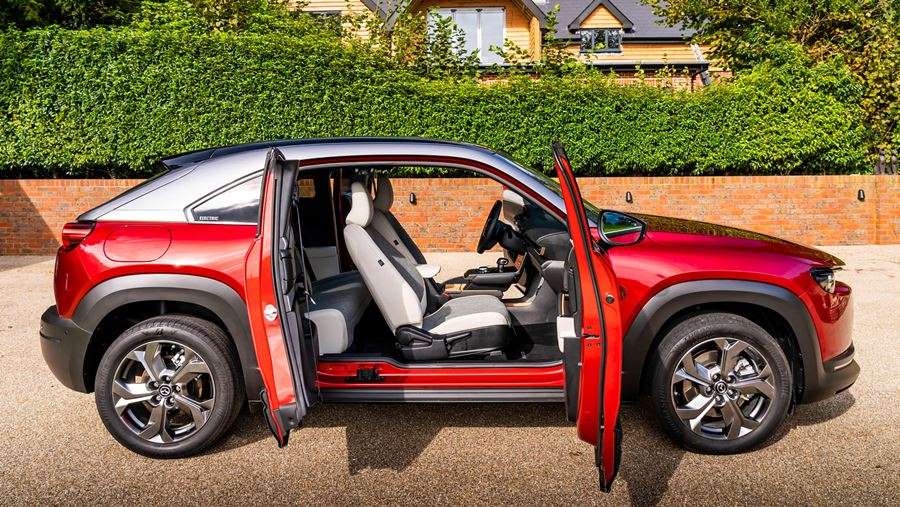
Interior & comfort
Mazda has incorporated renewable materials without any loss of quality
Mazda has long been known for its striking designs, and the CX-30 is no exception. Its interior follows the brand's recent uptick in quality adding some striking materials and features into the mix. The centre console trays and door handles are lined with cork from the bark of trees that have fallen naturally, while the door trim incorporates fibres from recycled plastic bottles. The only disappointment is some cheap plastic around the gear selector.
Its suspension is supple enough to ensure the MX-30 feels planted but doesn't bounce or skip uncomfortably around corners, so passengers should be comfortable. However, the driver will likely wish the rear windows weren't quite so sloping and dark, as they restrict over-the-shoulder visibility when manoeuvring. The mixture of touchscreen and rotary knobs for the ventilation controls also takes some getting used to.
Standard equipment is generous, including a head-up display, seven-inch digital instruments cluster, sat-nav and a rear-view camera. The First Edition trim level was available to the first 500 buyers and its design elements included 18-inch alloy wheels and light upholstery with grey cloth, stone leatherette and orange stitching. Two solid paint colours are available for free, or buyers can upgrade to a three-tone hue for around £1,000.
Following on from the First Edition, there's SE-L Lux, Sport Lux and GT Sport Tech trims. Sport Lux gets 18-inch alloy wheels, heated front seats with lumbar adjustment and keyless entry, along with the option of 'three-tone' contrasting paintwork. The GT Sport Tech range-topper features a sunroof, heated steering wheel, 12-speaker Bose stereo and front wiper de-icer, along with the option of artificial leather upholstery.
Practicality & boot space
Its rear-opening doors look cool, but hamper practicality somewhat
In a nod to the Mazda RX-8 sports coupe, the MX-30 features a set of rear-opening back doors. It’s an intriguing design, but there are compromises when it comes to functionality. For a start, they aren't as big as most rivals' back doors, and it's necessary to fold the front seat out of the way to get inside. It's also rather claustrophobic in the back of the MX-30, made worse by the fact the rearmost windows cannot be opened and a lack of kneeroom. Longer trips will be hampered by low and shallow seat bases that don't provide much thigh support to taller passengers but headroom is adequate.
The MX-30 has a sloping rear profile and stubby tail, with almost no overhang behind the rear wheels, so boot space isn't much better than in a supermini. There's up to 366 litres behind the rear seats but this reduces to 341 litres in the range-topping GT Sport Tech version.
It's possible to split and fold the 60:40 rear seats, but there aren't many clever features like an adaptable boot floor or hidden compartments, and space extends to 1,171 litres. With the engine bay taken up by the electric motor, there's also no 'frunk' like you'll find in some larger EVs. It's also likely the electric Mazda will follow the path of other small EV's and be deemed unsuitable for towing.
Reliability & safety
Owner satisfaction and safety are both strong areas for Mazda
Mazda has an excellent reputation amongst owners, who voted the Japanese brand into fourth place in our 2020 Driver Power satisfaction survey. They are impressed across the board, and find the interiors well screwed together, while running costs are also low. However, practicality was one area where improvement was deemed necessary, with more child-friendly features and flexible seating common requests.
Being an all-new model, there's no data yet on how the MX-30 will fare, but given Mazda's typical attention to detail and its new EV powertrain, we'd be surprised if it wasn't one of its most reliable models yet.
The MX-30 is certainly fitted with the latest safety tech, from autonomous emergency braking and lane-keeping, to a system that monitors the driver's attention levels. In the event of an accident, e-Call with GPS can also inform the emergency services and provide them the vehicle's exact location.
It all helped the MX-30 achieve a five-star safety rating from Euro NCAP, with impressive scores of 91% and 87% in the adult and child occupant protection categories respectively.
2020 Mazda CX-30 Road Trip Review: When Driving Doesn’t Matter
On the open road, our long-term Mazda CX-30 keeps its driver involved—too involved.
Mazda no longer uses "Driving Matters" as its tagline (now it's "Feel Alive"—already do, thanks), but that ethos is still imbued in every one of its vehicles. We agree with that mantra—mostly. Sometimes we'd trade involvement for relaxation, particularly when enduring long highway stretches as we've now done for several thousand road trip miles in our long-term 2020 Mazda CX-30. Turns out that when driving doesn't matter, this subcompact crossover is less than ideal.
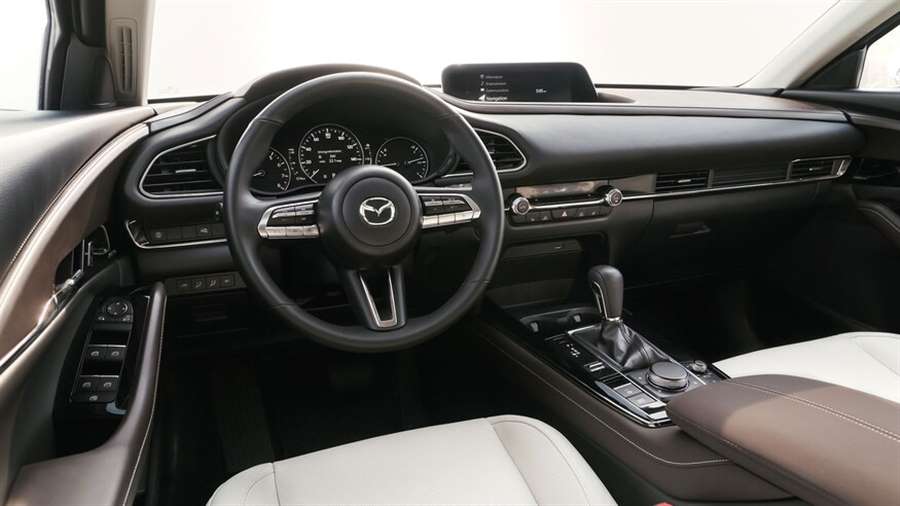
Nice as the CX-30's accurate, reactive steering is on a twisty road, managing it becomes a chore when coursing dead ahead. Lane-keep assist can be an awesome help in these scenarios, and the CX-30's spec sheet shows it as standard equipment. But on my recent drive between Los Angeles and San Francisco it did basically nothing, providing such minimal assistance that I checked a few times to see if it was turned on (it was). Other than gentle nudges seemingly at random, lane keep assist would allow the car to drift across markers with nary a beep. Autopilot this absolutely isn't.
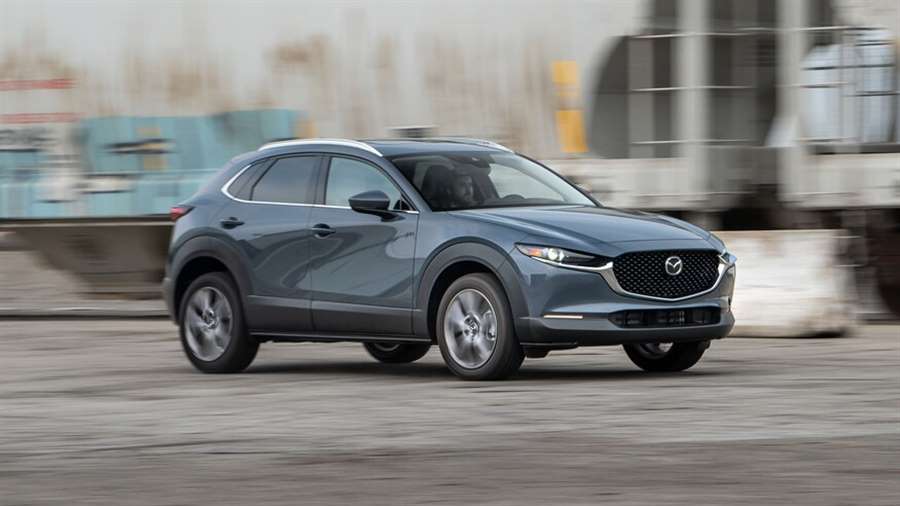
The CX-30 is also equipped with adaptive cruise control, which I came to call brake-check assist because of how committed it is to resuming its set speed after accelerating to pass. Instead of coasting down, the CX-30 brakes to reduce speed, causing some drivers I passed to brake in response. I'd have to override the car's action by applying throttle myself. Eventually I started turning adaptive cruise control off when passing, lest other drivers think I had a bone to pick—all involvement that systems like these are intended to negate. At least the blind-spot monitors effectively detect vehicles obstructed by the huge D-pillars.
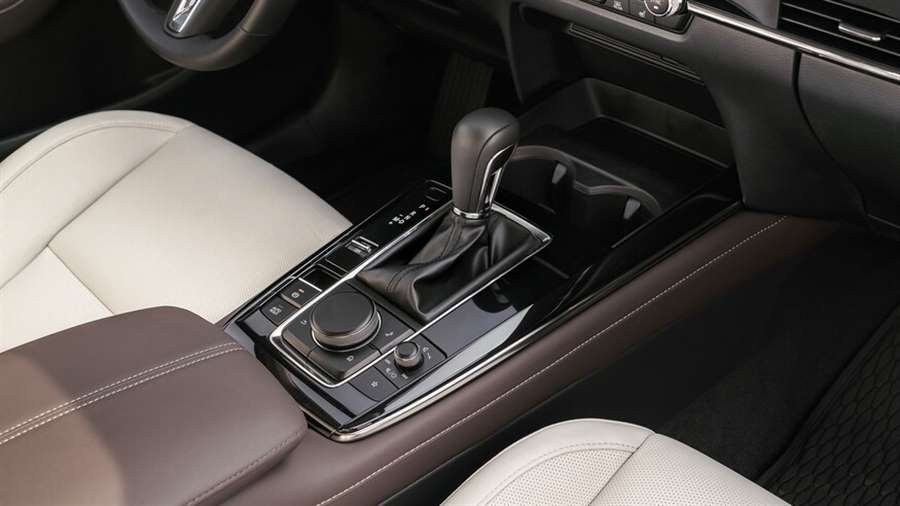
How Far Can The CX-30 Go On A Tank Of Gas?
Our logbook shows that the CX-30 struggles to cover more than 300 miles between fill-ups. I eked out 317 miles at best, but photographer Darren Martin reported refueling every 280 miles or so on his hilly trek from Los Angeles to Oregon. Given its 12-gallon tank, the CX-30's approximately 25-mpg average isn't impressive for a subcompact SUV. Long-haulers might find this Mazda's range frustratingly small, but I don't mind stopping to stretch about that often.
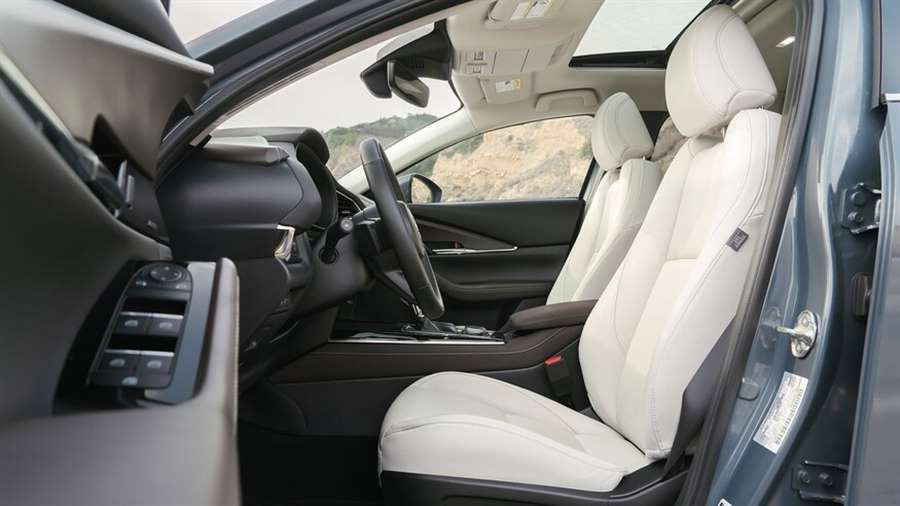
Thankfully the driver's seat kept my stretch breaks from becoming lengthy vinyasa sessions. The CX-30's front seats don't look all that special, but they feel excellent, providing ergonomic support all down the back. Their padding is neither too firm nor too plush, insulating nicely against the often busy ride. Cushy armrests and a leather-wrapped steering wheel made the CX-30 a nicer place to pass the miles.
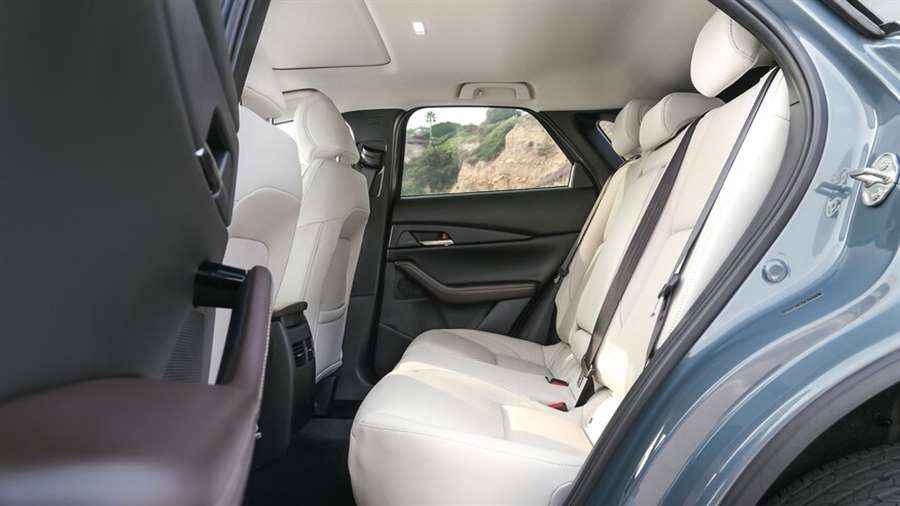
Too Sporty For Its Own Good?
On my solo road trip the CX-30 was just spacious enough to fit my luggage in the passenger seat and wheels-removed mountain bike over the folded-down second row. Fortunate that was, as my long weekend concluded with a trail ride in Santa Cruz. Carving toward the coast over forested Highway 17, the CX-30's pep and agility reminded me why driving matters. But afterwards, drained and digesting a post-pedal burrito, I just wanted to chill. Little such luck—the Mazda's involving setup kept me overly alert for the next several hours.
Our experience indicates that the CX-30 is better for around-town zipping than long-distance cruising. We'll see if that balance shifts as we pack on more miles.
2021 Mazda CX-30 Review: More Fun, Still Flawed
The verdict: The 2021 Mazda CX-30 is refined in many ways, and a new turbocharged engine option elevates it as a value alternative to many entry-level luxury SUVs. Beyond that, it lacks too many commonsense attributes for mass-market appeal.
Versus the competition: Upscale and fun to drive even if you don’t get the new turbo engine — and legitimately quick if you do — the CX-30 will deservedly find its loyalists. But many mass-market competitors have simpler controls, softer rides and roomier cabins.
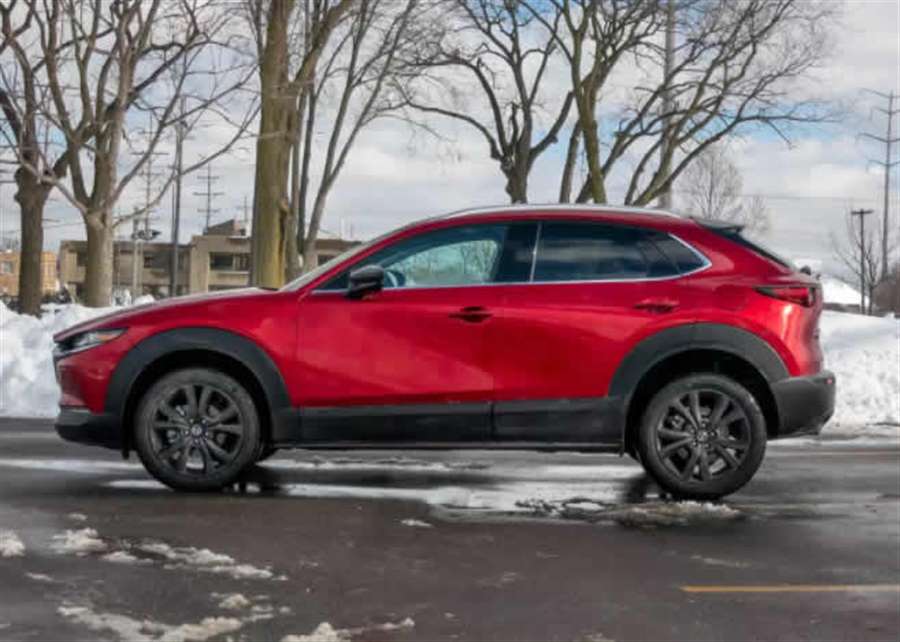
Based on the current-generation Mazda3 sedan and hatchback, the CX-30 enters its second model year for 2021 as a more viable alternative to the too-small Mazda CX-3 SUV. It comes in seven trim levels with front- or all-wheel drive and two available engines; stack them up or compare the 2020 and 2021 models. We evaluated a well-optioned turbo model for 2021, but I’ll mix in some impressions from the base-engine 2020 CX-30 that we tested in Cars.com’s recent Affordable Small SUV Challenge, where I served as a judge.
The CX-30’s third-place finish out of four SUVs in the comparison test tells much of the tale: Mazda’s small SUV drew top scores in some areas but bottom marks in others, with very little about it evoking neutral reactions. One model year later, Mazda plopped in a newly optional turbocharged four-cylinder, which matches the character of its carryover base engine: refined, steady power — just more of it. The fun’s been turned up, but the flaws live on.
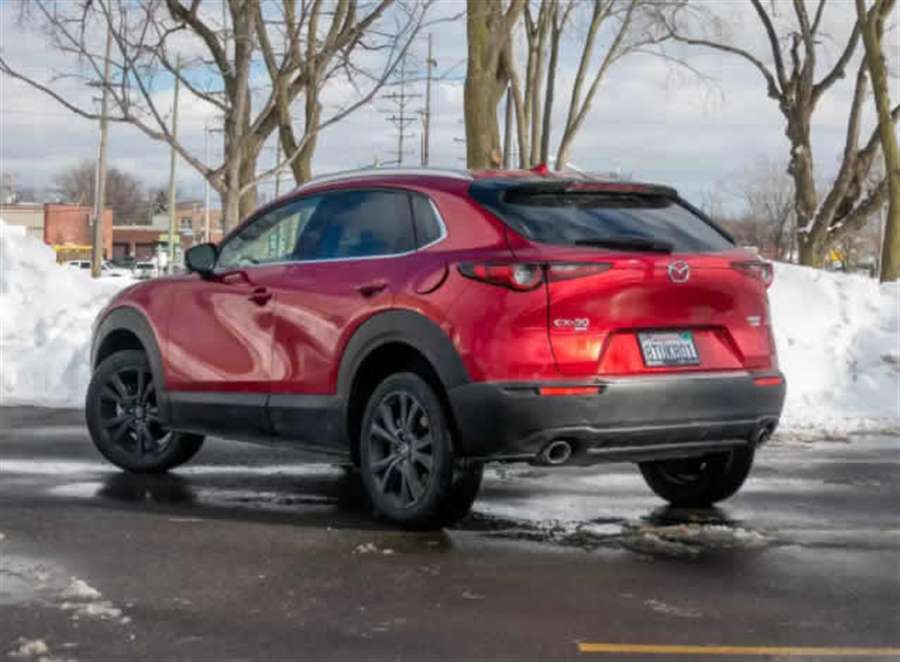
Refined Engines
In a field where pint-sized engines, many of them turbocharged, can lend tentative acceleration, the CX-30 is an old-school breath of fresh air. Its base engine, Mazda’s refined 2.5-liter four-cylinder (186 horsepower, 186 pounds-feet of torque) provides smooth if unspectacular power: sufficient from a start, with linear revving through any sustained on-ramp charge. It pairs with a six-speed automatic transmission whose tall gearing works against such drawn-out spurts — a disadvantage on paper, where rivals’ eight- or nine-speed units can make for shorter passing gears without diminishing fuel economy. But the six-speed earns its keep if you need more power while already in motion because downshifts are both decisive and immediate when you press the gas, an exercise many eight- and nine-speed automatics butcher.
Our comparison test exemplified how this plays out. We clocked a 2020 CX-30 with the 2.5-liter engine and AWD at a pedestrian 8.92 seconds to 60 mph, third slowest among four models (the others being a Chevrolet Trailblazer, Kia Seltos and Subaru Crosstrek, all with top available engines). Despite that, the CX-30 earned the group’s highest scores from our judges for overall powertrain impressions. Credit its consistent power delivery, which belies any absolute performance metric.

New for 2021 is Mazda’s turbocharged 2.5-liter engine, available only with AWD. It can run on regular gas but makes 250 hp and 320 pounds-feet of torque on 93-octane premium fuel, which our test car employed. (On 87-octane regular fuel, ratings for the turbo 2.5-liter drop to 227 hp and 310 pounds-feet of torque; the non-turbo 2.5-liter makes its output with either fuel.) Though significantly quicker past 2,500 rpm or so, the turbocharged four-cylinder’s power profile is similar to its non-turbo sibling — which is to say linear, building power over the full breadth of available engine rpm. Gearing remains tall, but the extra power makes the late upshifts less noticeable. And all the while, it’s gratifyingly quick.
The CX-30’s EPA-estimated fuel economy ranges from 25 to 28 mpg combined, depending on drivetrain. Versus a selection of mass-market rivals, the 2.5-liter falls a little short. Versus some entry-luxury models, whose interiors the CX-30’s top trims rival, the turbocharged CX-30 compares better.
Handling and Ride Comfort
Turbocharged or not, the CX-30’s reflexes are similar to the Mazda3 on which it’s based. Limited body roll, excellent steering feedback and surefooted brakes make the CX-30 a deft ally on winding roads. Wet conditions and temperatures in the 30s stymied our test car’s Bridgestone Turanza P215/55R18 all-season tires, which struggled on cloverleaf interchanges to hold course. Our CX-30 in the 2020 comparison had the same tires in better testing conditions, and we observed notable slippage there, as well. Wider or stickier tires might help — but if the CX-30’s rubber is the weak link on handling, it’s a mild one.
All that fun sacrifices ride comfort. Like the Mazda3, the CX-30 exhibits good overall straight-line composure, free of excess body movement on uneven surfaces; in this regard, it emulates a few entry-level luxury SUVs. But suspension tuning is unabashedly firm. The CX-30 exhibits a degree of impact harshness absent in many competitors, especially mass-market rivals like the Crosstrek and Nissan Rogue Sport — enough to turn off many shoppers who just want a smoother rider.
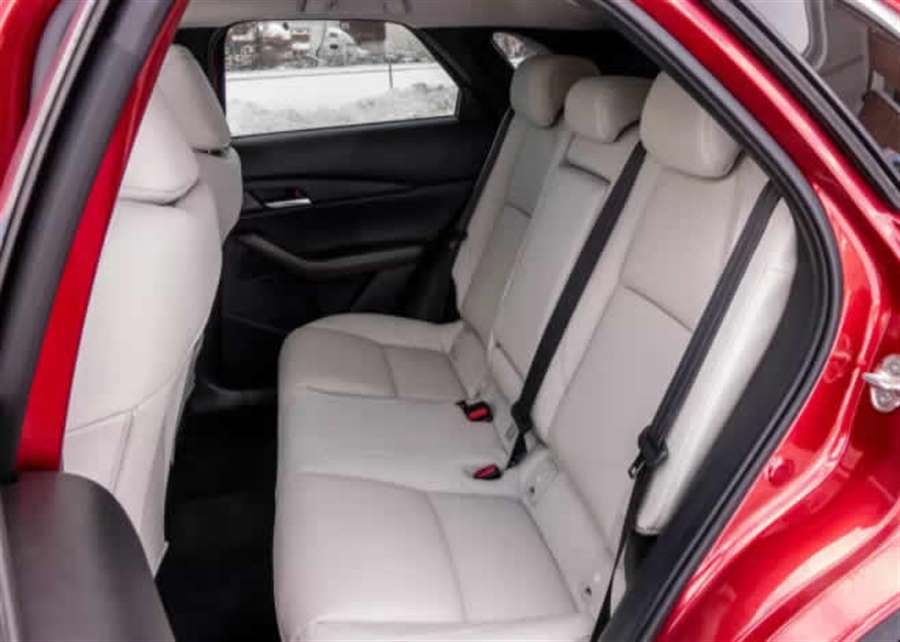
The Interior: Quality Over Quantity
For the most part, interior quality is strong. Controls boast meticulous detailing and operation, and most surfaces above knee level have consistent, low-gloss finishes. The CX-30’s optional leather seating surfaces are free of any obvious stretches of vinyl, and premium touches like universal one-touch windows hint at luxury territory. It’s not all excellent: A cheap headliner and some obvious cost-cutting in the backseat bring the CX-30 back to earth. By and large, though, this is a clear step above the SUV’s mass-market rivals. In our 2020 comparison, Mazda earned the highest interior quality scores by a clear margin, and in that regard may have fared well against SUVs priced far higher.
Despite that, interior quantity is marginal even if this is a larger alternative to the CX-3. The smallish backseat is ill-equipped to handle taller adults or even children in rear-facing car seats. Not only did it rank last in our comparison’s rear seats category, but it couldn’t fit Cars.com’s rear-facing child-safety seats without needing to move the front passenger seat so far forward that it may pose a safety risk for some adults seated there.
Even those who don’t plan to carry anyone in back often — children or otherwise — might find the CX-30’s confines, well, confining. The front seats have good sliding range but a narrow berth that could leave long-legged drivers feeling pinched. And as the CX-30’s relatively low-slung profile suggests, the driving position isn’t as high as you might expect of a conventional SUV. By our measuring tape, the CX-30’s driving position towers nearly half a foot above that of the low-riding Mazda3, but it trails the Seltos by roughly as much.
What’s more, the CX-30’s limited in-cabin storage and poor sight lines — especially out the rear window — are liabilities versus more utilitarian rivals; Mazda placed last in both categories (tied with the Crosstrek for storage) in our comparison. Cargo space, at 13.7 cubic feet by Cars.com’s independent testing, is a smidge above the Mazda3 hatchback (13.1 cubic feet, also by our accounting) and in the same neighborhood as the Trailblazer and Crosstrek, though the whole group falls well short of the Seltos’ as-tested 16.2 cubic feet.
Multimedia and Safety Technology
With the current-generation Mazda3 and now the CX-30, Mazda took a wayward turn on multimedia. No longer does the dashboard screen function as a touchscreen — even when the vehicle is stopped, as earlier iterations once did. It’s now a touch-free 8.8-inch display perched high atop the dashboard, controlled exclusively by a control knob and a few shortcut buttons on the center console. The setup especially stumps the CX-30’s standard Apple CarPlay and Android Auto integration, as both work best through a straightforward touchscreen.
Standard safety features include automatic emergency braking with pedestrian detection, lane departure warning with steering intervention and (impressively) adaptive cruise control down to a stop. The automatic braking passed third-party testing by the Insurance Information for Highway Safety, cementing the CX-30’s top scores across a battery of IIHS tests to earn the SUV a 2020 Top Safety Pick Plus award. (The award is likely to carry over for 2021, as the agency told us it has no plans to change criteria for the new calendar year.)
New for 2021, the CX-30 offers rear automatic braking, and top trim levels have new hands-on lane-centering steering by way of a feature called Traffic Jam Assist. Alas, TJA works only at speeds of 0-40 mph — a ceiling no longer imposed by most lane-centering systems available these days, regardless of price.
Should You Buy a CX-30?
Including destination, the CX-30 runs from just over $23,000 to about $36,000, a spread that overlaps a host of subcompact and compact SUVs to top out at the shores of the entry-luxury crowd. As a value alternative to the latter group, a CX-30 Turbo might justify itself; as a choice for driving fun among the mass-market models, a 2.5-liter example could also make sense. Given that the SUV ranks as Mazda’s second-best-selling model overall, it’s made the case to enough shoppers so far.
But larger market acceptance (the Crosstrek, for example, is three times more popular) will require a mainstream overhaul — a softer ride, bigger backseat, better visibility, simpler multimedia controls. As it stands, the normally aspirated CX-30 ranked in the bottom half of our 2020 comparison, and not for lack of quality or driving fun. With an infusion of high-end turbocharged trim levels, Mazda doubled down on everything we like, and it’s sure to get the CX-30 a cult following. But for all its remaining thorns, many mainstream shoppers may yet tune this Mazda out.
Source: cars.com
Sales of refreshed Mazda CX-5 started in Europe
The Japanese manufacturer has slightly redesigned an important member of the Mazda family - the CX-5 SUV. Sales in Europe have started, and the price in Great Britain is around 27,000 pounds.
The Mazda CX-5 was first unveiled in 2012 and was the first to embrace the Kodo design language and Skyactive technology.
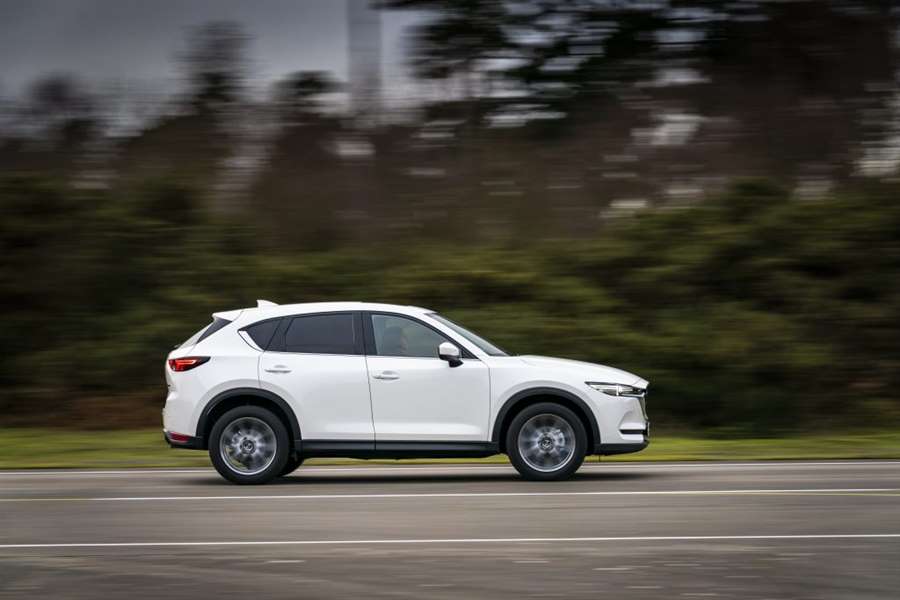
So far, 490,870 Mazda CX-5s have been sold in Europe, but still much more is sought outside the Old Continent, so globally that number is as much as 3.1 million, which makes this SUV the best-selling Mazda model.
An upgraded version of Mazda's mid-size SUV, the CX-5, brings innovations in technology, improved driving dynamics, and reduced CO2 emissions.
Engines and transmissions have also undergone slight improvements, so, among other things, the 2.2-liter Skyactive-D diesel engine with 184 hp is now offered for the first time with front-wheel drive.
The CX-5 also arrived in some markets in Europe in a version with a 2.5-liter Skyactive-G petrol engine of 195 hp, and there is a standard two-liter with 165 hp, which is offered with both front and 4 × 4 drive.
Changes to the engines have resulted in a cleaner and more dynamic ride, so, for example, the accelerator pedal has been optimized, which is now more responsive than before, then the engine, but also the six-speed automatic transmission.
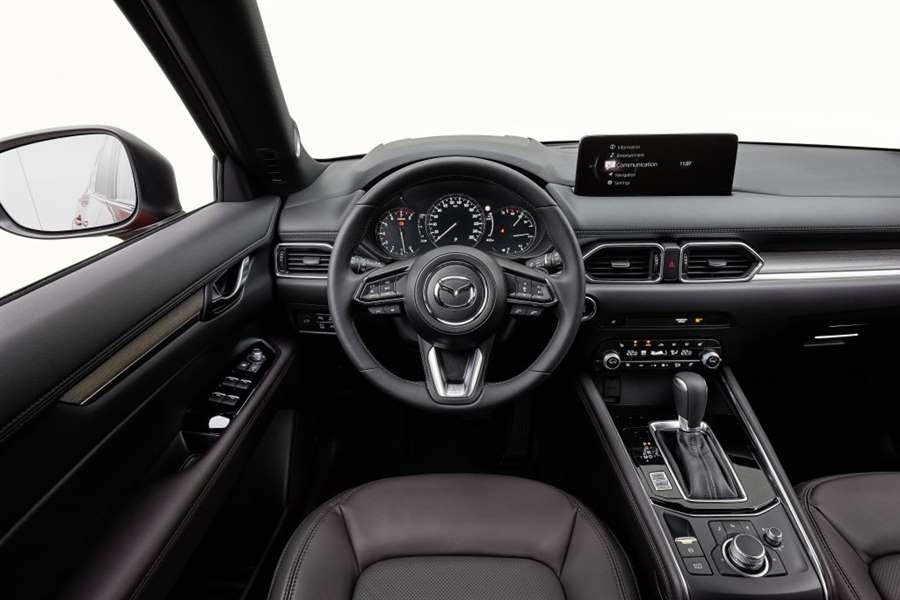
Now this SUV is also equipped with an improved HMI infotainment system, which is displayed on a larger 10.25-inch display, faster response and a cleaner display than before. Controller handling has also been improved, and new connectivity options for the Mazda app have been introduced.
In addition to the restyled CX-5, Mazda also offers a special edition of this SUV to mark the brand's 100th anniversary, called the Homura.
In Japanese, the word means flame, and this version differs from the standard ones by special black details of the exterior and interior, as well as 19-inch wheels.
2021 Mazda Mazda6
The 2021 Mazda6’s engaging ride and high-end cabin help it land in the top third of our midsize car rankings.
Is the Mazda6 a Good Car?
Yes, the Mazda6 is a good midsize car. It boasts adept handling, responsive steering, and two peppy four-cylinder engine options. It also has an upscale cabin and comes with an abundance of safety tech and infotainment features, including newly standard Android Auto and Apple CarPlay capability. Rear-seat legroom is slightly cramped, and its infotainment system isn't as user-friendly as those of rivals, but those are this Mazda's only major negatives.
Why You Can Trust Us: 56 Reviews Analyzed
We’ve analyzed 56 Mazda6 reviews, as well as performance specs, interior dimensions, fuel economy ratings, and more, to give you all the information you need to make a smart car-buying decision.
This 2021 Mazda6 review incorporates applicable research for all models in this generation, which launched for 2014.
U.S. News Best Cars has been ranking and reviewing vehicles since 2007, and our staff has more than 75 years of combined experience in the auto industry. To ensure our objectivity, we never accept expensive gifts from carmakers, and an outside firm manages the ads on our site.
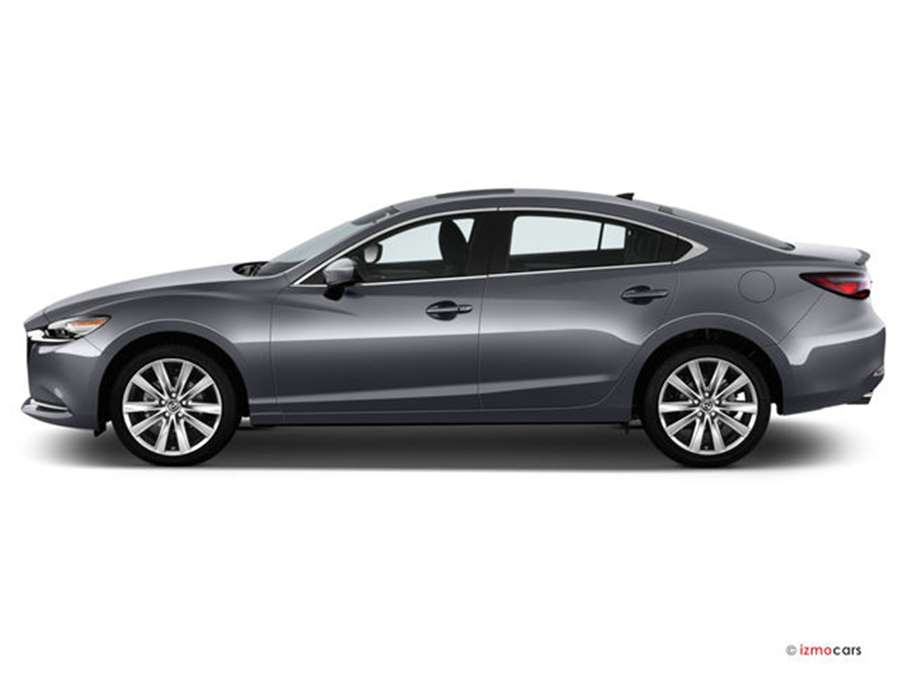
Should I Buy the Mazda6?
If you’re looking for a fun-to-drive midsize car, it’s hard to beat the Mazda6. That said, there are a few other vehicles worth considering before you make your purchase decision. The Toyota Camry is nearly as fun to drive as the Mazda, and it's available with a very strong V6 engine option. The Honda Accord isn't as athletic as the Mazda, but it offers more passenger space and additional cargo room.
2020 vs. 2021 Mazda6: What's the Difference?
For the 2021 model year, the Mazda6 gains standard Android Auto and Apple CarPlay, while wireless Apple CarPlay is newly available. Additionally, Mazda debuts a new Carbon Edition trim.
Here are the key changes for the Mazda6 over the last few years:
2017: upgraded infotainment system; Bluetooth and a rearview camera became standard; blind spot monitoring and rear cross traffic alert became standard in 2017.5 models
2018: refreshed interior styling; gained an available turbocharged engine and available Apple CarPlay and Android Auto
2019: gained some standard safety features; six-speed manual transmission discontinued
2020: no major changes
2021: Apple CarPlay and Android Auto added to standard features list; Carbon Edition trim introduced
If you're considering an older model, be sure to read our 2018 Mazda6, 2019 Mazda6, and 2020 Mazda6 reviews to help make your decision. Also, check out our Best New Car Deals and Best New Car Lease Deals pages to learn about savings and discounts you can find on new vehicles.
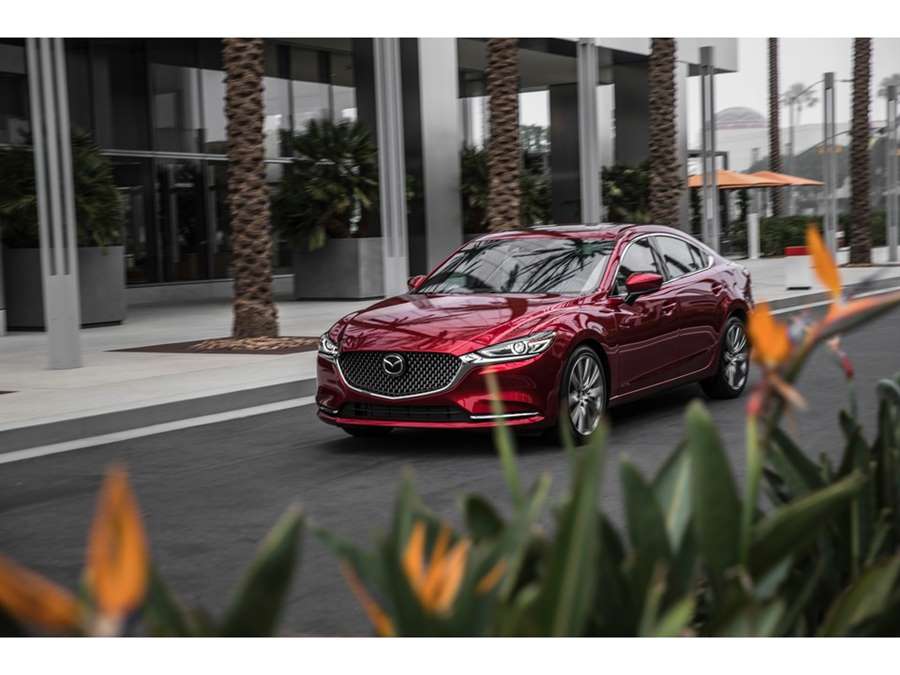
How Much Does the Mazda6 Cost?
The 2021 Mazda6 starts at $24,325, which is roughly average for a midsize car. The top-of-the-line Signature trim has a starting price of $35,750.
Check out our U.S. News Best Price Program for great savings at your local Mazda dealer. You can also find excellent manufacturer incentives on our Mazda deals page.
How Much Does It Cost to Insure a Mazda Mazda6?
The cost of insuring a Mazda Mazda6 will depend on a variety of factors, including your deductible, the level of coverage that you want, and the type of insurance that you choose. Your age, gender, location, credit score, and driving record can also have an impact on your insurance rates. Check out our car insurance guide to find the best policy for you.
Mazda6 vs. Toyota Camry
The Toyota Camry is just as enjoyable to drive as the Mazda6. The Toyota has plenty of power in its base four-cylinder engine, and its optional V6 engine is stronger than any of the Mazda's offerings. Additionally, the Camry has an easier-to-use infotainment system, a more spacious second row, a higher predicted reliability rating, and better gas mileage estimates. The Mazda6 is a good car, but the Camry is even better.
Mazda6 vs. Honda Accord
The Honda Accord and Mazda6 are neck and neck in our midsize car rankings, and choosing between them will come down to personal preference. The Mazda has more athletic handling, but the Honda offers two turbocharged four-cylinder engine options, and it delivers a gentle ride with lively handling. You’ll also get more passenger room and cargo space with the Honda. Ultimately, these are both solid picks; you can't go wrong with either.
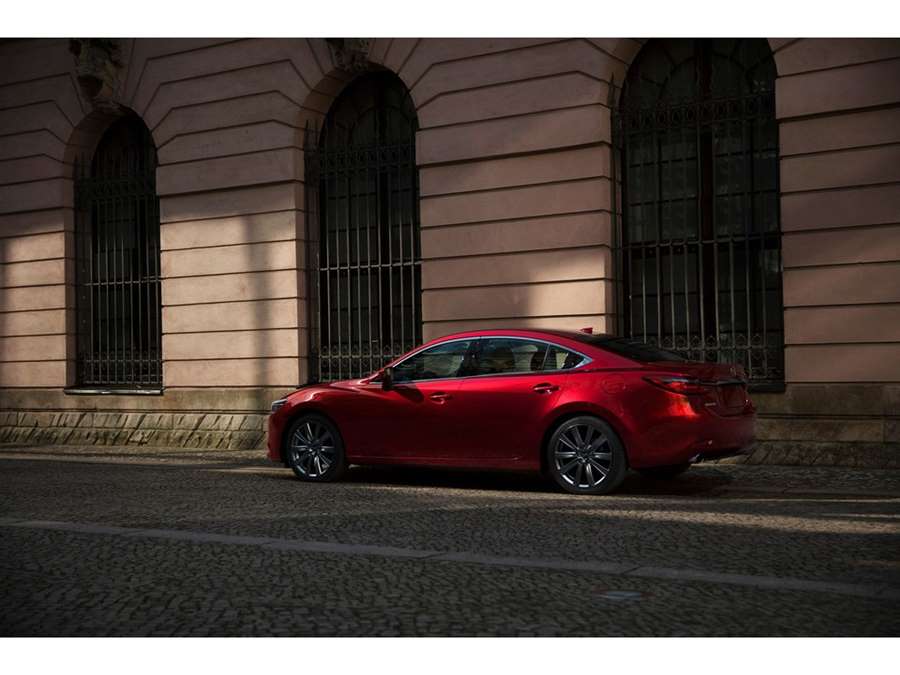
Mazda6 Cargo Space
This Mazda has a 14.7-cubic-foot trunk that provides enough room to store over a dozen grocery bags. The trunk is small for the class, however, and the release handles that fold down the back seats can only be accessed from the trunk. On the plus side, the 6 comes standard with 60/40-split-folding rear seats.
How Many People Does the Mazda6 Seat?
The Mazda6 seats up to five people. The front seats are well contoured, and there's adult-friendly seating throughout the cabin. However, some critics note that the car could benefit from extra rear-seat legroom.
Mazda6 and Child Car Seats
There are two complete sets of LATCH connectors for the rear outboard seats and a tether anchor for the rear middle seat. The middle seat can also borrow lower anchors from the adjoining seats. The Insurance Institute for Highway Safety gave this system the highest rating of Good+, which indicates that it's among the easiest to use.
Mazda6 Interior Quality
This Mazda has one of the nicest cabins in the midsize car class. Some reviewers say its upscale interior materials are close to what you would find in a luxury vehicle. Some optional comfort features include synthetic leather upholstery, genuine leather upholstery, ventilated front seats, and heated front seats.
Mazda6 Infotainment, Bluetooth, and Navigation
The Mazda Connect infotainment system comes standard in the Mazda6. This system features a touch screen, but its lockout feature prevents you from using touch controls while driving. Instead, drivers must use the central control knob when the car is in motion. Most critics praise the control knob as easy to use, but some complain that there are too many menus to wade through to get to certain functions.
Standard infotainment features: an 8-inch touch screen, six speakers, Android Auto, Apple CarPlay, HD Radio, Bluetooth, voice recognition, and two front USB ports
Available infotainment features: rear USB ports, satellite radio, wireless Apple CarPlay, an 11-speaker premium Bose stereo, and navigation
Additional standard features: push-button start, remote keyless entry, and dual-zone automatic climate control
Other available features: proximity keyless entry and a moonroof

Mazda6 Engine
A 187-horsepower 2.5-liter four-cylinder engine is standard in the Mazda6. A turbocharged four-cylinder that produces 227 or 250 horsepower (depending on the grade of gasoline you pump into the tank) comes standard in Grand Touring trims and up. Both engines are paired to a six-speed automatic transmission that delivers smooth shifts. The base engine is powerful and helps the vehicle accelerate quickly, but the upgraded engine offers significantly more pep.
Mazda6 Gas Mileage
The 2021 Mazda6 gets 26 mpg in the city and 35 mpg on the highway in its standard setup, which is about average for the midsize car class. Models with the upgraded engine get an EPA-estimated 23 mpg in the city and 31 mpg on the highway.
Mazda6 Ride and Handling
The Mazda6’s responsive steering and athletic handling help make it a thrill to drive, without sacrificing ride comfort. Front-wheel drive is standard. All-wheel drive is not available.
Is the Mazda6 Reliable?
The 2021 Mazda6 has a predicted reliability rating of three out of five, which is about average.
Mazda6 Warranty
Mazda covers the 2021 Mazda6 with a three-year/36,000-mile basic warranty and a five-year/60,000-mile powertrain warranty.
Mazda6 Crash Test Results
The National Highway Traffic Safety Administration gave the 2021 Mazda6 an overall safety rating of five out of five stars, with five stars in the frontal and side crash tests and four stars in the rollover test.
The Insurance Institute for Highway Safety named the 2021 Mazda6 a Top Safety Pick+, giving it the highest rating of Good in all six crash tests and the second-highest rating of Acceptable for how well its headlights illuminate the road ahead. Models with adaptive headlights earned the highest rating of Good.
The IIHS uses a different scale for grading collision avoidance features. It gave this car the highest rating of Superior for its standard vehicle-to-vehicle front crash prevention system, as well as the second-highest rating of Advanced for its standard vehicle-to-pedestrian system.
Mazda6 Safety Features
Standard advanced safety features:
Automatic high-beam headlights
Rain-sensing windshield wipers
Lane departure warning
Lane keep assist
Forward collision warning
Forward automatic emergency braking
Pedestrian detection
Adaptive cruise control
Blind spot monitoring
Rear cross traffic alert
Rearview camera
Available advanced safety features:
Head-up display
Front and rear parking sensors
Reverse automatic emergency braking
360-degree parking camera system
Traffic sign recognition
Driver attention alert
Adaptive headlights
Mazda6 Dimensions and Weight
The Mazda6 is about 16 feet long. Its curb weight ranges from 3,437 to 3,582 pounds, and its gross vehicle weight rating is between 4,473 and 4,552 pounds.
Where Is the 2021 Mazda6 Built?
Mazda builds the 2021 Mazda6 in Japan.
Which Mazda6 Model Is Right for Me?
The 2021 Mazda6 comes in six trims: Sport, Touring, Grand Touring, Grand Touring Reserve, Carbon Edition, and Signature. The base Sport trim is filled with infotainment, safety, and comfort features, which make it a great pick for most shoppers. The Sport and Touring trims come with the base four-cylinder engine, while every other trim gets the upgraded turbocharged engine.
Mazda6 Sport
The Sport trim (MSRP: $24,325) comes with an 8-inch touch screen, six speakers, Android Auto, Apple CarPlay, HD Radio, Bluetooth, voice recognition, and two front USB ports. Other standard features include push-button start, remote keyless entry, dual-zone automatic climate control, a leather-wrapped steering wheel and shift knob, cloth upholstery, and six-way manually adjustable front seats.
A host of active safety features are also standard, including lane departure warning, lane keep assist, forward collision warning, forward automatic emergency braking, pedestrian detection, adaptive cruise control, blind spot monitoring, rear cross traffic alert, automatic high-beam headlights, rain-sensing windshield wipers, and a rearview camera.
Mazda6 Touring
Starting at $26,925, the Touring trim gains rear USB ports, synthetic leather upholstery, heated front seats, a six-way power-adjustable driver's seat, proximity keyless entry, and a moonroof.
Mazda6 Grand Touring
The Grand Touring trim starts at $30,025. In addition to the turbocharged engine, the Grand Touring adds satellite radio, and an 11-speaker premium Bose stereo.
Mazda6 Grand Touring Reserve
The Grand Touring Reserve trim starts at $32,525 and gains wireless Apple CarPlay, adaptive headlights, genuine leather upholstery, ventilated front seats, an eight-way power-adjustable driver's seat, a six-way power-adjustable passenger seat, a heated steering wheel, and a head-up display.
Mazda6 Carbon Edition
The Carbon Edition trim (MSRP: $32,800) adds red leather upholstery, red and black interior accents, and gloss black exterior accents.
Mazda6 Signature
The top-of-the-line Signature trim has a starting price of $35,750. It gains ambient lighting, Nappa leather upholstery, navigation, traffic sign recognition, a 360-degree parking camera system, front and rear parking sensors, and driver attention alert.
Source: cars.usnews.com
2021 Mazda3 Turbo: More Appealing, Still Niche
The verdict:
Endowed with the model’s first turbocharged gas engine since the Mazdaspeed3 left showrooms early last decade, the 2021 Mazda3 can muscle past slower traffic with little effort — a commanding, if reserved, degree of performance that should raise the car’s appeal among Mazda fans. Still, broader obstacles remain for mass-market audiences.
Versus the competition:
The Mazda3 is among the most fun-to-drive cars in its class, and a new engine only furthers that strength. But for daily driving, many competitors are easier to live with.
As before, the 2021 Mazda3 is available as a sedan or hatchback, with standard front-wheel drive or optional all-wheel drive. Last year’s four-cylinder engine carries over for most models, but Mazda bookends it with two new ones: a smaller four-cylinder in base trim sedans, and the turbocharged four-cylinder in high-end sedans and hatchbacks.
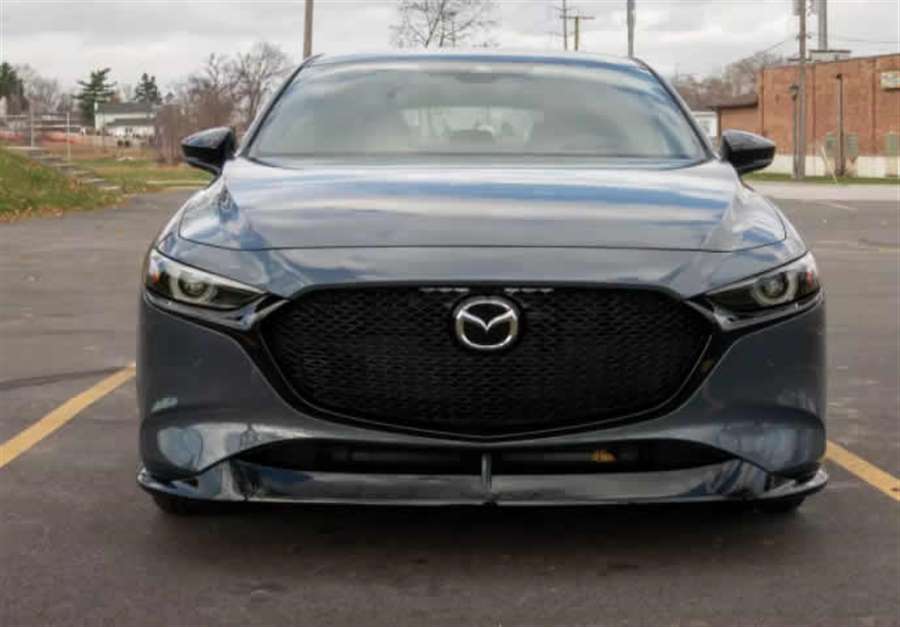
Seven trim levels (base, S, Select, Preferred, Premium, Turbo and Turbo Premium Plus) run the gamut from the low-$20,000s to the mid-$30,000s with factory options; automatic transmissions come on all except the Premium hatchback, which is available with a manual. Stack the gang up here, or compare the 2020 and 2021 Mazda3 here.
We drove a Mazda3 Turbo Premium Plus hatchback, though we’ve also evaluated the current generation, both in sedan and hatchback form, with the mid-level engine.
Powered Up
Although we haven’t tested the base engine, its limited availability means just a sliver of shoppers will buy it. Most Mazda3 examples are likely to have the 2.5-liter four-cylinder, which was the only engine available in the 2019-20 Mazda3. It’s a capable, smooth-revving engine, though tall gearing from Mazda’s six-speed automatic transmission limits some of its potential. Accelerate from a stop up to highway speeds, and it’s a long climb through 2nd and 3rd gear — but if you hit the gas while already in motion to tack on more speed, the same automatic readily downshifts without undue delay. You hate it, you love it.
I’ll get to the turbo four-cylinder in a moment, but first some context on how it stacks up:
- 2.0-liter (FWD base sedan only): 155 horsepower, 150 pounds-feet of torque; six-speed automatic only
- 2.5-liter (FWD or AWD, sedan or hatchback, most trim levels): 186 hp, 186 pounds-feet of torque; six-speed manual or six-speed automatic
- Turbocharged 2.5-liter (AWD only, sedan or hatchback, Turbo or Turbo Premium Plus trims): 250 hp and 320 pounds-feet of torque (using 93-octane premium gas) or 227 hp and 310 pounds-feet of torque (using 87-octane gas); six-speed automatic only
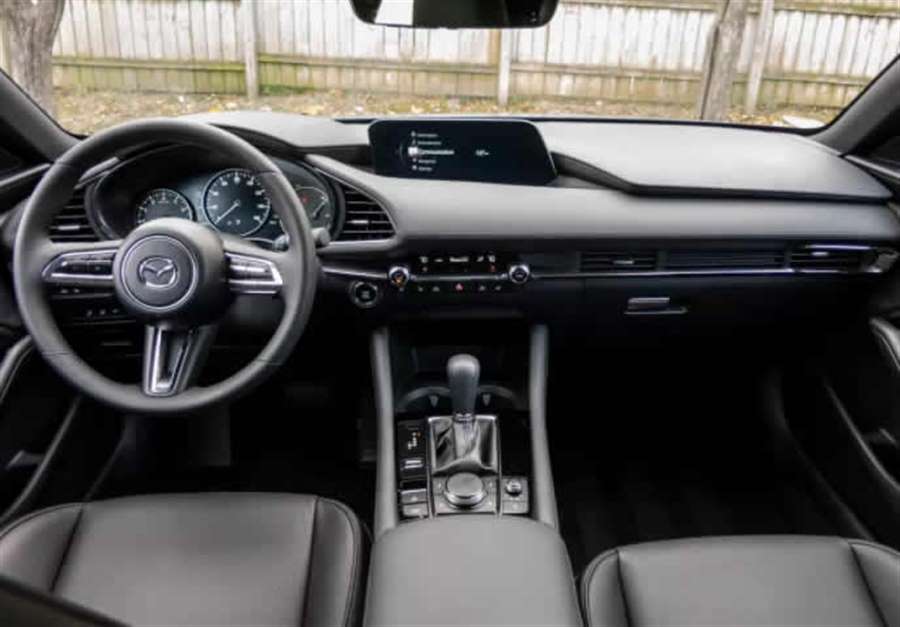
Our test car came filled with 93-octane premium fuel, according to the fleet company that dropped it off. In any case, the drivetrain behaves in some respects like a diesel engine, with torque aplenty for vigorous starts but modest power progression once you get past 4,000 rpm or so. It’s not quite a plateau — some additional power still comes if you rev it out — but the drivetrain feels best suited to muscle past slower traffic as you apply steady gas, as opposed to flying around near redline with your foot to the firewall. Accelerate while already in motion and the transmission resists downshifts notably more than with the non-turbo 2.5-liter, but the Mazda3 Turbo’s vast torque and responsive accelerator absolves it.
Ride and Handling
Our impressions from when we first drove the current-generation Mazda3 still stand, which is to say ride quality is polished but firm. Although the suspension employs a cheaper torsion beam setup in back — as opposed to the independent rear suspension offered on previous generations of the Mazda3 — the chassis maintains good body control and clean, reverb-free shock absorption. But tuning is decidedly firm and probably more than what most compact-car shoppers will tolerate. Mazda cites a retuned front suspension with stiffer springs for the Turbo, and it does little to change the car’s character; softer-riding rivals like the Nissan Sentra, Toyota Corolla and Volkswagen Jetta seem better suited for the daily grind. The Mazda3 improves on the Honda Civic’s perpetual bounciness, but that isn’t saying much. Mazda shouldn’t wait for a full redesign to revisit suspension tuning.
Like the Civic, the Mazda3 redeems itself on the handling front, perhaps even more so in the Turbo. Mazda claims the AWD system on Turbo models can distribute more torque to the rear wheels, and the car indeed feels more neutral around sweeping corners than its non-turbo sibling. You can slide the tail a touch with aggressive mid-corner gas, something the non-turbo Mazda3’s AWD all but prohibited, and understeer remains well contained throughout.
Mazda claims retuned steering hardware for sharper response on all Mazda3 variants for 2021. The ratio still isn’t as quick as some rivals’, but feedback remains very good. Flinging the Mazda3 around cloverleaf sweepers is a lively, communicative experience — an increasingly rare quality these days, even among sporty cars.
Interior and Tech
Cabin materials in the well-equipped Mazda3 we evaluated were exemplary for this class. Mazda’s optional leather upholstery would feel at home in any entry-level luxury car — cloth and leatherette (imitation leather) are also available — and generous padding covers the armrests and areas your knees touch. Controls feel meticulous all around, and most surfaces — save a low-budget headliner — appear universally rich. Impressively, the backseat sees little drop-off in materials quality, a widespread practice among Mazda’s rivals.
In contrast to all that, the Mazda3’s multimedia system remains a weakness. It constitutes a high-mounted dashboard screen measuring a healthy 8.8 inches diagonally, but the ultra-wide aspect ratio limits overall display size with just 3 inches of screen height. Apple CarPlay and Android Auto come on all but the base sedan, and CarPlay leverages the screen’s full width, but the backup camera does not. What’s more, the screen isn’t a touchscreen — not that such functionality would help much, as it’s mounted too far forward to easily reach — and requires a knob-based controller behind the gear selector. For straightforward user-friendliness, that’s a step backward; the related Mazda CX-30 SUV has the same system, and it ranked last for usability of controls in a recent four-car comparison we conducted.
Seating and Cargo Space
Craftsmanship notwithstanding, the Mazda3 isn’t particularly roomy or easy to see out of. The driver’s seat sits relatively low to the ground, and larger drivers will no doubt find the space narrow between the center console and doors. The hatchback blocks over-the-shoulder views with giant roof pillars and a tiny rear window; the sedan has mercifully thinner pillars, though rear glass is still undersized.
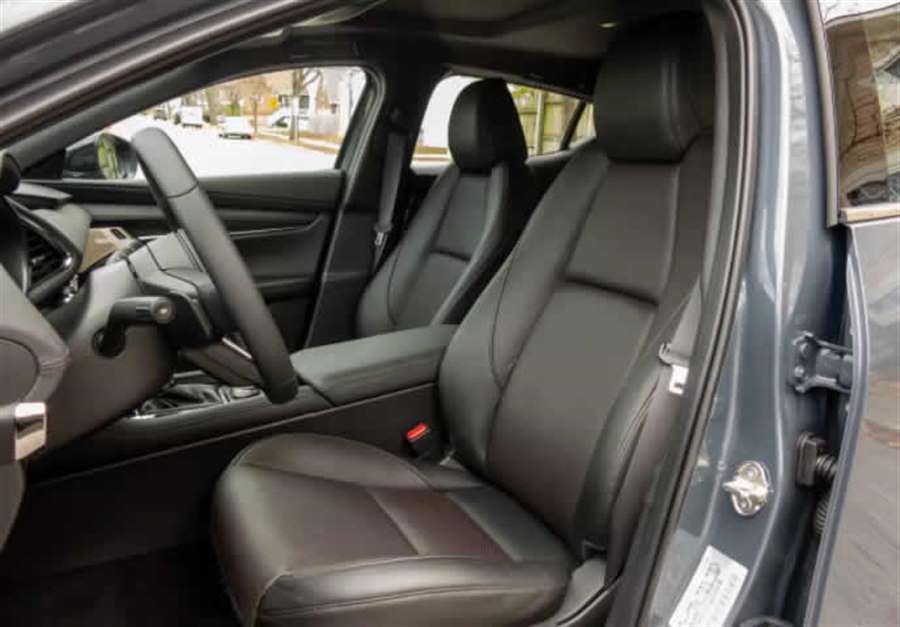
Backseat knee clearance is tight, and we measured a modest 13.1 cubic feet of cargo volume behind it. That’s through Cars.com’s independent cargo measurements, not manufacturer-advertised specs, which we’ve found unreliable. Versus the Mazda3 sedan, the hatchback carries inherent advantages to maximizing cargo space when you fold the backseat down, but for those who need to carry passengers and cargo, the sedan may have considerably more room. Although we didn’t have access to a 2021 model-year sedan to measure cargo space with our latest methodology, we found the current-generation sedan’s trunk roughly a third deeper than the hatchback’s cargo area — with similar width and height to the tops of the seatbacks — when we tested both body styles two model years ago. (There is more space above the backrests in a hatchback, but loading above this height compromises cargo containment and rearward visibility, both safety hazards.)
That’s not surprising. Indulge me a minute on this: Manufacturer-stated cargo specs usually employ separate methodology between hatchbacks and sedans, rendering spec comparisons tenuous at best. The Mazda3 hatchback isn’t necessarily an outlier, with as-tested cargo volume similar to that of most entry-level SUVs in our recent comparison. But you’ll find more cargo volume in many sedans, and less in many hatchbacks and SUVs, when measured the same way — which is to say, up to the tops of the seatbacks. With apples-to-apples methodology, the current Civic, Sentra and Corolla sedans have some 40-50% more usable cargo volume than a Mazda3 hatchback.
Should You Buy a Mazda3?
With the base 2.0-liter four-cylinder, the Mazda3 starts at $21,445 with destination, which is competitive for the class. Standard features include the automatic transmission, 16-inch alloy wheels, one-touch power windows all around and the 8.8-inch multimedia system, albeit without CarPlay or Android Auto. Also standard are stop-and-go adaptive cruise control, lane departure warning with steering assist, and forward collision warning with automatic emergency braking. The well-rated AEB helped the 2020 sedan and hatchback both earn top ratings from the Insurance Institute for Highway Safety, but IIHS has yet to publish ratings for the 2021 model as of this writing. When available, the 2021 report and its changes, if any, can be found by searching for “Mazda 3” here.
Higher trim levels, including all hatchbacks, all have the smartphone integration and 2.5-liter engine. Spend more and you can get heated leatherette or leather seats, a moonroof, dual-zone climate control, a power driver’s seat and Bose premium audio. Newly optional for 2021 are rear automatic braking, a 360-degree camera system and Traffic Jam Assist, a low-speed lane-centering steering system that’s now here following availability overseas.
Those who want the Mazda3 Turbo will shell out at least $30,845 for the sedan, with the hatchback running another $1,000. Turbo models with the Premium Plus addition (leather, Traffic Jam Assist and the safety extras, in-dash navigation and more) edge close to $35,000, with prices spiraling past that once you add premium paint and various cosmetic enhancements. That kind of money falls somewhere between performance mass-market compacts and entry-level luxury sedans.
As such, there’s a Mazda3 for many performance thresholds. A few years into its fourth generation, Mazda’s least expensive car remains a fun-to-drive choice among compact sedans and hatchbacks. The turbo engine extends the spectrum, though it doesn’t change the nameplate’s limited appeal for left-brained shoppers. As I said when the current generation arrived on scene for the 2019 model year, the Mazda3 seemed destined for niche appeal. The Turbo does much to add appeal — less so to expand the niche.
Source: cars.com
Our 2019 Mazda CX-5 Turbo Was Easy to Love
From its excellent road manners to its upscale interior to its perfect reliability over 40,000 miles, Mazda's compact crossover served us well.
You don't have to say "compact crossover" three times in a row to make one appear; the parking lot is already full of them. They've scared away most of their car counterparts, but it's crossovers like the Mazda CX-5 that make us think maybe the future isn't so spooky after all.
Our CX-5 arrived in the top Signature trim with flashy Soul Red Crystal Metallic paint and 19-inch dark-silver aluminum wheels. The leather-wrapped steering wheel and wood trim gave it a luxury feel despite its less than exorbitant price. The Caturra Brown interior combined good-quality dark dash materials with brown ventilated leather seats brought a very upscale finish to the cabin. A few accessories were added; all-weather floor mats went to good use, a rear bumper guard probably saved the CX-5 from a few blemishes, and a roof rack went largely unused.
A 250-hp turbocharged 2.5-liter four-banger and all-wheel drive come standard in Signature trims, but it's the 310 pound-feet of torque that gives the CX-5 an almost diesel-like power delivery. Print director Eric Tingwall pointed out, "This engine is tuned for a strong low-end tug from zero to 30 mph at about 50-percent throttle. When you floor the accelerator and ride it out through the relatively low redline, the engine feels a bit coarse and reluctant. I remember Mazda saying something about zoom-zoom, but this engine doesn't have any of that spirit." At 40,000 miles, however, the 2.5 did show a little more enthusiasm, delivering better acceleration times across the board.
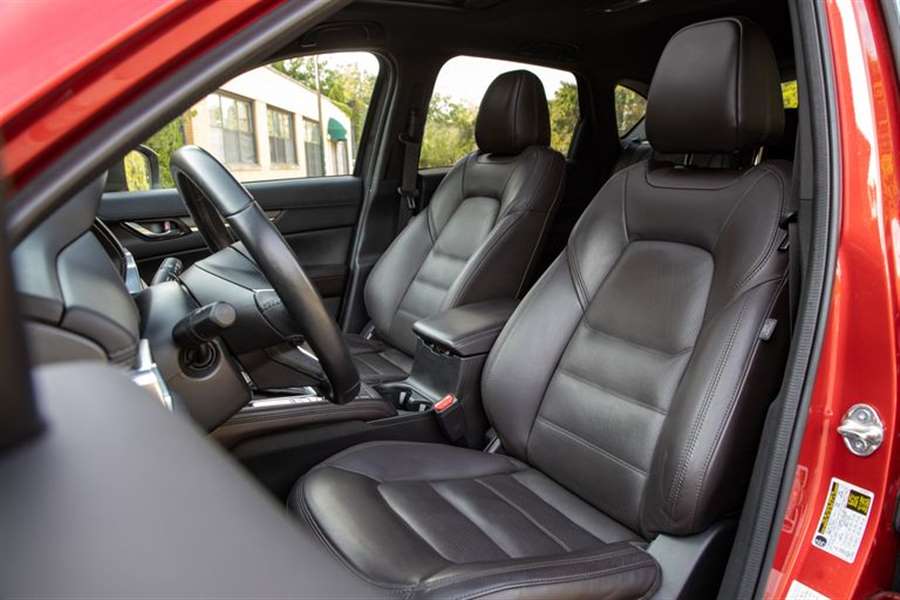
But that tuning makes sense for the small-crossover use case, which doesn't typically involve regular trips to redline. It does involve regular trips, however, and on that front the CX-5 was often passed over in favor of more capacious competitors. We found the CX-5 stylish inside and out and a pleasure to drive, but its tight cargo space and lack of towing capability explains why it was overlooked for family trips. There were several staffers who asked about it having a trailer hitch—no, it didn't—but even if it did, the CX-5 maxes out at a 2000-pound tow rating. Other long-termers with more cargo space, like the Honda Passport, were often selected ahead of the Mazda despite the CX-5 delivering a more upscale driving experience.
LOWS: Lack of cargo space and not the most fuel-efficient commuter.
The CX-5 completed its test without any hiccups or gaffes, despite being rummaged through by a would-be car thief. We took it to Mazda for six scheduled maintenance visits throughout its long-term test, regular 7500-mile services, and an additional stop right at 40,000 miles to replace the spark plugs. That cost $293, although at the same time the dealer noticed that we were wearing thin of rear brake pad and that those rotors were also warped. Add $574 to the normal-wear column. In terms of reliability, the CX-5 couldn't have been more consistent if it had taken a fiber pill every morning.
The most frequent gripes concerned the Mazda's tiny and slow infotainment system. Sometimes the menu would just freeze after startup or get stuck in a loading cycle when switching between menus. This system has since been upgraded for 2020 models, solving its lagginess. We've been in a new CX-5, and the larger 8.0-inch touchscreen is also a big improvement.
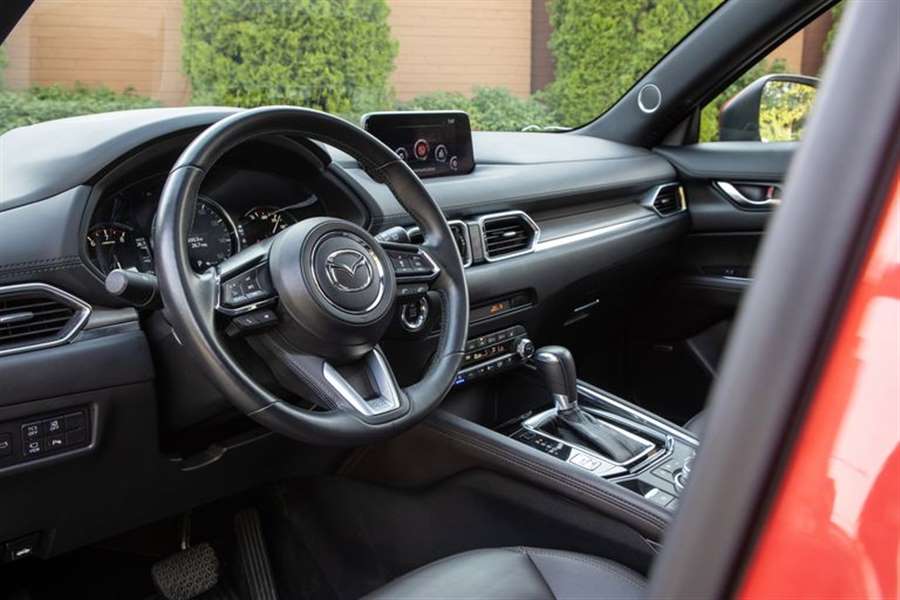
How much we like driving this 10Best-winning vehicle should not be diminished by how long it took us to reach 40,000 miles. We took delivery in March 2019 and only made it to 30,000 miles a year later, before quarantine started. It took another six months to knock out the last 10,000 miles. In contrast, our long-term Kia Telluride reached 10,000 miles in only its first three months, but its three rows and usable tow rating makes it far more friendly for a road trip with four or more people.
The CX-5 took us plenty of places, just nowhere very far from home. Most trips were local. It did a lot of commuter work (back when we were still commuting to work), and it ran a lot of errands. Assistant technical editor Maxwell Mortimer was the long-distance champ, venturing as far south as Tellico Plains, Tennessee, and driving 200 miles north of the office to Harrisville, Michigan for a camping trip. We averaged 24 mpg, matching the combined EPA-estimated mileage. We achieved 30 mpg during our 200-mile highway fuel-economy test near the 40,000 mile mark, which also matches the EPA's estimate, but it's still behind the all-wheel-drive Toyota RAV4, Nissan Rogue, and Honda CR-V. But we'd rather burn fuel in the CX-5.
After 40,000 miles we still appreciate the luxurious look and feel of the CX-5's comfortable leather seats, as well as its six-speed automatic transmission in a field rife with continuously variable automatics (CVTs). We wish its competition could step it up and offer the same effortless steering and controlled suspension as the CX-5—or that the Mazda could provide the cargo space of a Honda CR-V or Nissan Rogue. The perfect crossover doesn't exist, but we respect the CX-5's prioritization of the driving experience. Better to be really good at one thing rather than mediocre at everything.
Months in Fleet: 18 months Current Mileage: 40,206 miles
Average Fuel Economy: 24 mpg
Fuel Tank Size: 15.3 gal Observed Fuel Range: 360 miles
Service: $971 Normal Wear: $574 Repair: $0
Damage and Destruction: $0
30,000-Mile Update
The past 30,000 miles of our long-term test with the turbocharged Mazda CX-5 have been trouble-free, uneventful bliss. It’s been the type of ownership experience you’d hope for with any vehicle. There hasn’t even been a single unscheduled maintenance visit or factory recall yet.
The CX-5 has drawn some unwanted attention, though. One night, while parked at a C/D staffer’s apartment complex, someone got into the presumably unlocked CX-5 and rummaged through the glove compartment and center console but left without stealing anything—and we had a bag of tools and a USB cord in there. It’s possible the would-be thief was scared off by something, but it makes us think that this CX-5 is a lucky one.
The 250-hp turbocharged 2.5-liter inline-four under the hood remains a staff favorite. That said, there are a few entries in the logbook that criticize the moment of turbo lag that exists at low rpm. And some staff members complain that this engine lacks power when you twist the tach past 5000 rpm. Quipped deputy reviews editor Tony Quiroga, “This engine makes low-end power and runs out of enthusiasm at high revs like a Fox-body Mustang ‘5.0’ V-8. The quotes are there of course because that engine is actually a 4.9-liter.”
We continue to be grateful that Mazda employs a six-speed automatic instead of a CVT. Shifts are crisp and quick, and the CX-5 never suffers from the dreaded droning sound that CVTs utter under acceleration. We do enjoy the faint sighs of the turbocharger’s pressure relief valve recirculating air on most shifts.
To celebrate his completion of a two-week quarantine after returning from a press trip in Italy, assistant technical editor Maxwell Mortimer took a 1400-mile road trip to the Tennessee–North Carolina border just before Michigan’s shelter-at-home decree hit. He writes that “the CX-5 is awesome. I can’t help but keep comparing its level of entertainment with a Volkswagen GTI's.”
Senior editor Joey Capparella also took it on a trip to Tennessee, where he noted the CX-5’s unexceptional highway fuel economy: “I had to fill up about every 350 miles or so. Out of boredom, I tried to get the low-fuel warning light to show zero, but I chickened out at 17 miles.”
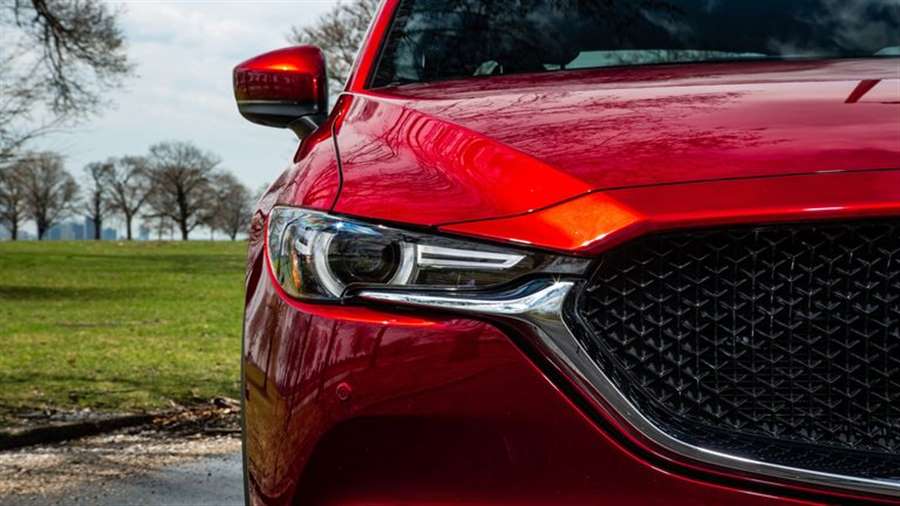
The CX-5 appears to have a very conservative fuel gauge, though, because when Capparella compared the tank size with the quantity he pumped, the Mazda had over two gallons left in the tank. During Capparella's trip, his average fuel economy registered 29 mpg, or 1 mpg short of what an identical CX-5 managed during our 200-mile highway fuel-economy test. Had he wanted to, Capparella could have likely pushed it beyond 400 miles before having to seriously start looking for a gas station.
Since our last update, we’ve maintained a steady 24 mpg in combined driving. Currently, the CX-5 is driving on Nokian Hakkapeliita R3 SUV winter tires, which have taken the worst the winter could throw at them. Now that spring is here, we’ll be swapping to the original equipment: Toyo A36 all-season rubber.
Inside, the nappa-leather-trimmed driver’s seat is beginning to become a bit glossy as more and more butts slide in and out of it. Small creases and wrinkles are appearing, too. Left alone and in the warmest setting, the heated seats reach uncomfortably hot temperatures. Within minutes, you end up turning them off for fear of searing yourself. The 7.0-inch touchscreen is a bit frustrating, as it often lags and takes a long time to boot up when you turn on the CX-5. You find yourself waiting for it to load, stuck watching a gear icon spin on the screen for about 20 seconds. It’s one of the few gripes we have, though, as the rest of the interior has an upmarket design and feel.
We still have 10,000 miles to go before our loan ends. We'll see if the CX-5 can maintain its perfect reliability record. We look forward to the day when we can take it for another road trip. Right now, we’ll have to settle for quick runs to the grocery store.
Months in Fleet: 13 months Current Mileage: 30,375 miles
Average Fuel Economy: 24 mpg
Fuel Tank Size: 15.3 gal Observed Fuel Range: 360 miles
Service: $574 Normal Wear: $0 Repair: $0
Damage and Destruction: $0
20,000-Mile Update
It has taken nearly a year for our long-term Mazda CX-5 to cross the halfway point in its 40,000-mile stay with us. But that gradual mile accumulation is not for the Mazda's lack of goodness as a compact SUV. While we're not petty enough to shy away from the CX-5's handsome styling, excellent driving character, and trouble-free reliability because of its irksome infotainment system, that aging interface is about the only thing we have been able to consistently criticize.
Indeed, our Mazda is so agreeable that most of the very few entries in its logbook center on the small 7.0-inch infotainment display and both its slow response and less than seamless operation. "It's irritating to have to navigate into menu structures just to browse radio stations," wrote print director Eric Tingwall. "A dedicated seek or tuning control is desperately needed. I normally like these control-knob-based systems, but if it's going to be this clumsy, I'd rather just use the touchscreen." While Mazda has enlarged that touchscreen to 8.0 inches in higher trim levels as part of its updates to the CX-5 for the 2020 model year, this operating system still feels clunky and dated compared to the brand's newer setup found in its Mazda 3 and CX-30 models.
Still, after more than 20,000 miles and no shortage of fresher competitors to sample, the CX-5 continues to impress with its optional 250-hp turbocharged 2.5-liter inline-four. While that engine gains an additional 10 lb-ft of torque to 320 lb-ft for 2020, we don’t miss it on our 2019 model. It might not be the quickest in the compact-crossover segment—that would be the new Ford Escape with its optional turbo 2.0-liter four—but the CX-5 turbo's smooth, responsive power delivery impart to it a little of the MX-5 Miata's spunky personality. We're also pleased with the Mazda's average fuel economy of 24 mpg, spot on with its EPA combined estimate.
Additional satisfaction comes from the CX-5's six-speed automatic transmission, which shuffles gears smartly and effectively enough, especially in Sport mode, that we never feel shorted by the lack of paddle shifters on its steering wheel. Compared to the often mushy and droning continuously variable automatic transmissions found in many of the CX-5's peers, this six-speed 'box is refreshingly well tuned for both lazy and spirited driving. Staffers continue to levy similar praise on the precise and direct steering, the sorted body control that resists disturbances from Michigan's shoddy roads, and the pleasantly upscale interior of our top-spec Signature model.
The CX-5 also has been wholly reliable. Unlike many of our other current long-termers, not even a flat tire or a cracked windshield has interrupted the Mazda's clean streak. Our only visit to the dealer since our last checkup was for scheduled maintenance at around 21,000 miles, which amounted to $162 for an oil and filter change, cabin air filter replacement, and tire rotation.
Employed as a utility vehicle, the CX-5 is as capable as it is enjoyable to drive. Road warrior Scott Olman was able to fit a dining room table and six chairs in the back of the Mazda with both of its rear seats folded, which is pretty respectable in any compact ute. The colder temperatures of winter in Michigan also have helped us appreciate the effectiveness of the CX-5 Signature's standard heated front seats and steering wheel, although a shortage of snow thus far has meant we've had little opportunity to test out the excellent foul-weather traction of the Nokian Hakkapeliitta winter tires we've installed. There is still plenty of time for more of the white stuff to fall, though, and for us to put many more miles on the CX-5.
Months in Fleet: 11 months Current Mileage: 22,636 miles
Average Fuel Economy: 24 mpg
Fuel Tank Size: 15.3 gal Observed Fuel Range: 360 miles
Service: $427 Normal Wear: $0 Repair: $0
Damage and Destruction: $0
10,000-Mile Update
So far, the road to 40,000 miles in our Mazda CX-5 has been smooth, even as winter descends on these Michigan roads. There's nothing shocking about compact crossovers, other than the rate at which consumers keep buying them. So far, the CX-5 has performed as expected, with a few minor annoyances sprinkled on top.
As part of our current 17-car long-term test fleet, the Mazda CX-5 conceals its handsome face behind our more interesting, and sometimes problematic, vehicles. It's easy to be overshadowed by, say, our 362-hp twin-turbo Mercedes wagon, or a long-termer that shall go nameless but is tethered to the future of driverless cars and also has a fart button. (Yes, it's our Tesla Model 3.) The CX-5 is like a comfortable knee brace: you don't want to wear it, but when you do it's not so bad, because it's good at what it's supposed to do.
Our long-termer has the new-for-2019 250-hp turbocharged 2.5-liter inline-four. This engine is only available with all-wheel-drive models. Just after we ordered ours, Mazda added a 2.0-liter diesel engine option. The price of our all-wheel-drive Signature trim CX-5 is $39,850, which got us a Bose sound system, adaptive headlights, a heated steering wheel, heated front and rear seats (ventilated in front), and a 360-degree parking camera. The options on ours put it far from the $25,395 CX-5's base price and closer in price to the Jeep Cherokee or the GMC Terrain Denali.
Our experience with the turbocharged engine has generated few comments, which is a good thing. If engineers can create something to keep automotive journalists from complaining, they should box it and sell it to the masses. Mazda appears to have done just that. The new turbo engine emits a noticeable moan. The noise is somewhat expected for an engine that can send the CX-5 from zero to 60 mph in only 6.1 seconds. We've found the CX-5's 187-hp base engine feels underpowered—or, in other words, boring. Which is an adjective we would use to describe most patients in the hospital wing of compact crossovers. Our CX-5 wishes them a full recovery.
That isn't to say our romance with the CX-5 has been perfect. An overwhelming number of entries in the CX-5's logbook cry over slow infotainment loading times. After startup, several staffers were terrorized with the inability to change the SiriusXM channel from E Street to Fly FM fast enough. The 7.0-inch touchscreen loads at the same rate that old hips dance to Springsteen. On occasion, SiriusXM suffered from repetitive lost-signal errors, a problem annoying enough that one of us said it would prevent them from buying a CX-5.
Another common bruise in the logbook was the low-res camera. The 7.0-inch touchscreen is already barely larger than phones tagged XL, but the camera quality was deemed poor by three staffers who had driven the vehicle long distances. The longest trip was an 800-mile weekend journey by testing director Dave VanderWerp, who was unimpressed by the CX-5's driver-assist technology. The absence of lane centering means that when the CX-5 begins to wander from its lane, it doesn't automatically correct and nudge the car back to safety. The CX-5 just buzzes, which isn't much help compared to some of its cheaper rivals with similar assistance tech.
A fresh set of Nokian Hakkapeliitta R3 winter tires came in handy earlier this week, when the first major snowfall hit the Midwest. Senior editor Joey Capparella wrote: "These Nokian winter tires feel pretty unstoppable. The heated seats and steering wheel get nice and toasty." Meaning staffers looking forward to working from home on snow days should not take the CX-5 the night before.
The CX-5 has been back to the dealership twice, but only for routine maintenance to change engine oil, rotate the tires, and for inspections at the 7500- and 15,000-mile marks. The cabin air filter was also changed, but other than that, our CX-5 has been trouble-free.
Through its first 10,000 miles, the CX-5 has not been the first pick by staffers rushing to lunch on Taco Tuesday. Not because it's bad, but because it's just fine. Now that we've entered snow season here in the mitten state, we'll be monitoring its competence in dealing with Siberian conditions and its ability to whisk us to warmer, sunnier climes.
Months in Fleet: 8 months Current Mileage: 16,331 miles
Average Fuel Economy: 24 mpg
Fuel Tank Size: 15.3 gal Observed Fuel Range: 360 miles
Service: $265 Normal Wear: $0 Repair: $0
Damage and Destruction: $0
Introduction
Mazda has few obvious problems, but if prodded to highlight some, we'd cite weak brand recognition in the United States and a shortage of fun paint colors, particularly for the MX-5 Miata. If that sounds as if we're reaching, well, we are. The automaker's products are so uniformly likable that finding things to gripe about takes some pedantic effort. Mazda is also pushing hurriedly upmarket, a development that is as easily seen through the lens of the CX-5 crossover as it is in any of Mazda's recent products.
Like the recently updated Mazda 6 sedan, CX-9 SUV, and all-new Mazda 3 sedan and hatchback, the CX-5 stands a head or two above similarly priced mainstream competitors, in this case, the Honda CR-V, Toyota RAV4, and Chevrolet Equinox. The brand enjoys an enviable quirk: More than half of its sales mix, model for model, consists of the higher trim levels. Mazda has taken this to mean that buyers can and want to pay more for their vehicles, which has spurred it to add ever more deluxe Grand Touring Reserve and Signature trims above the previously top-dog Grand Touring spec on some models, the CX-5 included. We've taken the same development as license to sign up for a 40,000-mile long-term test in a loaded 2019 CX-5 in range-topping Signature trim. We for sure wanted to get the newly available turbo 2.5-liter inline-four in our long-termer, and the only way to do that is with the Grand Touring Reserve or Signature trim level. The lesser Sport, Touring, and Grand Touring trims make do with a naturally aspirated 2.5-liter. And we're not above spoiling ourselves with a top-spec example.
So what does a compact Mazda crossover costing BMW money deliver? For starters, the impression that it should cost BMW money. The CX-5 looks, inside and out, like something that belongs in the compact-luxury-SUV segment. It's mostly true, even at the CX-5's $25,395 starting price, and particularly so on the $37,935 Signature trim. Adding our test car's gorgeous $595 Soul Red paint, $70 cargo mat, $125 floor mats, $400 backlit doorsill accents, $125 rear bumper guard, $250 retractable cargo cover, and $400 roof rack rails brings the final tally to just $39,900. This, we should point out, is for the gas-powered Signature; after we took delivery of our test car, Mazda introduced a diesel engine option available only on the Signature trim. Pricing with that engine starts at $42,045.
LOWS: More people should know what Mazda is.
Mazda includes a number of features that push competitors' nicer trim levels toward the same $40,000 mark, though none of those vehicles does as good an impression of a near-luxury product. (We're looking specifically at the GMC Terrain Denali and Jeep Cherokee, which cost $42,670 and $43,150 when equipped similarly to our CX-5 Signature.) The Signature brings as standard equipment some active-safety gear that's optional on several competitors, including automated emergency braking, adaptive cruise control, blind-spot monitoring, rear cross-traffic alert, and lane-departure warning.
Also standard on the Signature: lovely Caturra Brown nappa leather seating, real wood trim, a Bose audio system, dual-zone automatic climate control, power-folding door mirrors, adaptive headlights that point into corners, a power liftgate, power-operated and heated front and rear seats (ventilated in front), a heated steering wheel, a 7.0-inch touchscreen that can also be controlled via a central control knob, navigation, a 360-degree parking camera, front and rear parking sensors, and that aforementioned turbo four, which cranks out 250 horsepower. There are no major options offered beyond a few accessories.
The 2.5-liter in lesser CX-5s makes 187 horsepower, and all-wheel drive is a $1400 upcharge on Sport, Touring, and Grand Touring models. The turbocharged CX-5s are sold only with all-wheel drive. Like every modern, automatic-transmission Mazda, the CX-5 uses the brand's slick-shifting six-speed unit.
The combination of a turbo gasoline engine and all-wheel drive delivers a 6.1-second zero-to-60-mph time and punchy acceleration at most speeds (certainly stronger than with the base gas engine). More of a huffer than a screamer, the turbo four shoves the Mazda along on a wave of low-end torque. It might not be thrilling in the "zoom-zoom" sense, but Mazda doesn't lean on that phrase for marketing anymore, so let's not dwell on the idea that a compact crossover's engine needs to feel racy in order to be wholly effective. For now, we're calling the power delivery a possible hang-up when set in the Mazda brand's predominantly sporty context; we'll deliberate further over the next 40,000 miles. So, stay tuned as we live with our luxurious Mazda day in and day out and see whether our early positive impressions of its smooth ride, quiet interior, and fine road manners are affirmed or challenged.
Source: caranddriver.com
Rare Rides: The 1990 Mazda 929, a Traditional Japanese Luxury Sedan
Today marks the second time a Mazda 929 will grace us here at Rare Rides. Late last year we featured the successor to today’s car, a pristine 929 from 1992. That smooth sedan had frameless windows, rounded shapes everywhere, and was designed specifically with the North American market and Lexus customers in mind.
Let’s take a look a the much more conservative luxury sedan Mazda designed before Lexus existed.
The car North America called 929 was known in its home market as Luce. Dating back to its debut in 1967, the Luce was Mazda’s flagship. A smaller manufacturer, Mazda did not field a full-size sedan for some time. Available in coupe, sedan, and wagon formats, the Luce remained mid-size through the ’77 model year. For ’78 the LA4 series Luce grew into a larger executive car, leaving the midsize segment to the Capella (626). In its new larger form the Luce coupe went away, and the model’s three-body lineup was maintained via a standard sedan, hardtop sedan, and a wagon. The market segment of the departed Luce coupe was filled from that point onward by the Cosmo.
The LA4 generation didn’t last for long and was replaced by the HB for 1982. Once more the Luce grew in size. Reflecting future trends early, there was no more wagon in the HB generation, only a sedan and hardtop. The hardtop HB had a very interesting front end treatment, by the way. HB had a good run and remained in production through 1986. The Cosmo continued on the HB platform through the rest of the Eighties, and HB was the last time the two cars shared underpinnings.
For model year ’87, HB became HC, and the Luce experienced another growth spurt. Again available in sedan and hardtop guises, the Luce/929 was sold in two sizes. Hardtop versions were longer and wider, at 194 inches and 67.9 inches, respectively. Standard sedans were 184 inches long, and 66.7 inches wide. Though traditional in its form, Mazda saw fit to offer a zesty Wankel engine in addition to standard I4 and V6 power. Inline-fours were of 2.0- or 2.2-liter guises. There was also a tiny 2.0-liter V6, and (in North American examples) a 3.0-liter V6. Notably, the J-series engine was the first V6 Mazda produced. The rotary option was a 13B, a twin-rotor 1.3-liter mill which was not offered in North America. Some Luce trims were in fact more luxurious than the 929 offered in America, as Mazda reserved its rotary power, adjustable suspension, and console refrigerator for the home market.
Mazda saw fit to import only the sedan to North America, feeling no need to come with hardtop length. Canadians had more options than Americans eh, as they received a standard Winter Package on their 929s. That meant a tougher alternator, winter tires, wipers that didn’t hide themselves under the hood, and heated seats. The vast majority of North American 929s were automatic, but a five-speed manual was theoretically available.
The most notable change in the 929’s timeline on these shores was the addition of the S trim for 1990. The 18-valve SOHC engine was upgraded to DOHC, and 24 valves. Performance and fuel economy both increased with this upgrade; horsepower jumped from 158 to 190. S also added two-tone paint and excellent lace alloys.
The 929 was too dated, too traditional, and a slow seller. Mazda got the most mileage out of its new V6 in North America via the very interesting rear-drive MPV. The 929 was replaced with the previously featured generation in 1992. Worth noting, Koreans absolutely loved the HC 929. Once Mazda stopped building it, they sold the design to Kia. Kia did a light front and rear rework and sold it as the Potentia from 1992 until 2001. The 929-cum-Potentia’s base 2.0-liter engine also saw use in the first generation Kia Sportage for many years.
Today’s Rare Ride is located in Germany because Americans can’t take good pictures when they have a 929 for sale. This V6 asks $10,500.
Source: thetruthaboutcars.com

